NEWS Portal of Gigahertz Optik GmbH®
On the following page, our news portal, we will provide you with the latest information and news on product innovations, software updates, event announcements and many interesting topics from Gigahertz Optik GmbH. Here you have the possibility to get a picture of our developments at any time. If you have any questions, please contact our technical sales department. We will be glad to help you.
Always up-to-date bei product developments und updates, our latest press releases and current information on events in which we participate
CIE Position Statement on Color Quality Metrics
CIE Position Statement on Color Quality Metrics
The color perception of object colors has been an ongoing topic for a very long amount of time. This motivated scientists from all over the world to find a theoretical description of color rendering. This culminated in 1965 in the CIE's publication of the General Color Rendering Index Ra. The index has since then been accepted widely and been broadly applied in both scientific and industrial applications.
However, the CIE General Color Rendering Index Ra is not perfect. This became especially apparent with the rise of LED based light sources and luminaires. In many, cases the narrowband characteristics of LEDs led to a significant mismatch of the calculated Ra values and actual color rendering perception through humans. Hence, work on color rendering metrics was continued. This led to the publication of the CIE General Color Fidelity Index Rf in CIE 224:2017 [1]. This new index is based on 99 test color samples. Their distribution is optimized on capturing color rendering properties of LEDs and other sources to a much finer degree than is possible via the General Color Rendering Index Ra (based on only 14 test color samples).
Since 2017, the Color Fidelity Index Rf has been widely applied and a good agreement with human color rendering perception has been confirmed. Hence, CIE decided to recommend using the General Color Fidelity Index Rf not only in scientific but also in industrial application by the whole lighting community [2]. The aim is to replace the Color Rendering Index in the near future. The transition to the new metric should be alleviated by reporting both the old General Color Rendering Index Ra alongside the new General Color Fidelity Index Rf.
Gigahertz-Optik has introduced the CIE General Color Rendering Fidelity Index Rf alongside the Color Gamut Index Rg into all of its current spectroradiometers [3]. Calculating and displaying those values is supported by all devices of the BTS256 and BTS2048 series with sensitivity range from 360 nm to 830 nm or beyond. In addition, the measuring devices MSC15, CSS-45 and LIGHTmetric One offer Rf and Rg as measurands as well. Furthermore, in order to support current CIE recommendations all of those devices still display the classic CIE General Color Rendering Index Ra.
Related Links:
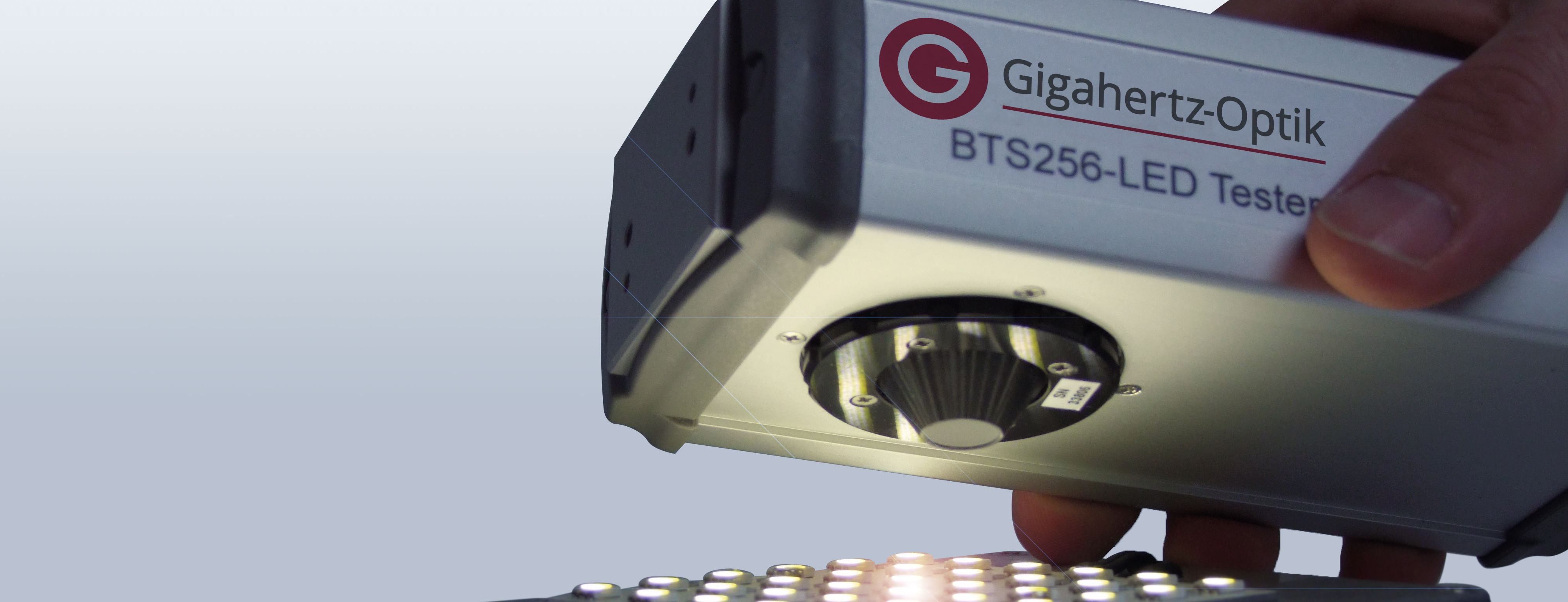
Gigahertz-Optik Introduces Two New BTS256-LED Tester versions (UV, NIR)
New BTS256-LED-UV & BTS256-LED-IR Models Available
In October 2024, Gigahertz-Optik expands its successful BTS256-LED tester product line with two new versions: the BTS256-LED-UV and BTS256-LED-IR. These portable, compact measuring devices, equipped with the proven "BiTec Sensor" system, are specially designed for precise measurement of UV and IR LEDs. Like the standard model for photometric, colorimetric, and spectral radiometric testing in the visible range, the new testers also feature an integrated integrating sphere with a conical measurement port. This allows LEDs on circuit boards to be tested both in handheld operation and in fixed setups. The devices measure radiant power, spectral power distribution (SPD), peak intensity, and other parameters.
An additional UV or IR auxiliary LED for absorption correction, typically only found in stationary LED measurement systems, enables even more precise measurements—controlled via the included software. This makes the new testers ideal for applications in quality assurance, research and development, as well as production monitoring.
Technical specifications of the new models
- BTS256-LED-UV: Calibrated spectral range from 200 to 550 nm, optical bandwidth of 5 nm (CIE 214 correction). Radiant power measurement range from 10 µW to 2 W (typical for a 350 nm LED).
- BTS256-LED-IR: Calibrated spectral range from 750 to 1100 nm, optical bandwidth of 5 nm (CIE 214 correction). Radiant power measurement range from 0.3 µW to 5 W (typical for a 900 nm LED).
The control and evaluation are fully managed via the S-BTS256 software, which offers all key functions such as integration time, mathematical corrections, and measurement parameters.
Traceable Calibration in the In-House ISO/IEC 17025 Laboratory
The BTS256-LED testers are calibrated in Gigahertz-Optik's ISO/IEC 17025 accredited calibration laboratory. Two calibrations ensure maximum precision: A specially designed reference lamp with 2pi emission is used for the accurate measurement of diffusely emitting LEDs. The second calibration is tailored for narrow-beam light sources.
Versatile Use in the Visible Spectral Range
For photometric, colorimetric, and radiometric measurements in the visible range, we recommend our BTS256-LED Plus concept, which extends the functionality of the tester for a wide range of applications.
Contact Us
For more information or to discuss your specific application, our team is happy to assist you:
Gigahertz Optik GmbH
Phone: +49 (0)8193-93700-0
Email: info@gigahertz-optik.de
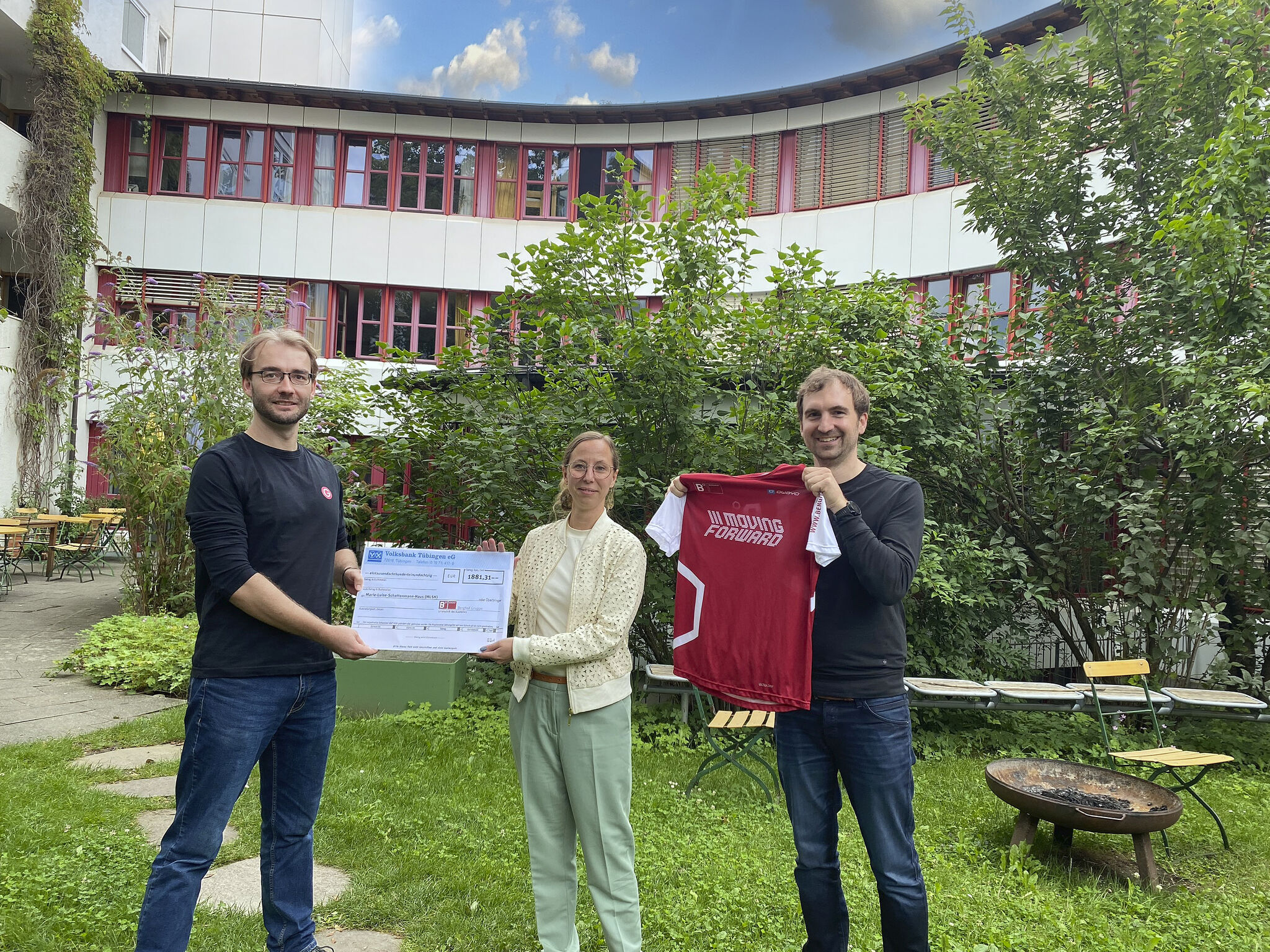
What an honour
Donation handover of the Berghof Group Moving Forward Challenge!
We at Gigahertz Optik GmbH had the honour of distributing the donations on behalf of the entire Berghof Group.
We decided in favour of a local project in Munich - the Marie-Luise-Schattenmann-Haus. In addition to all the big well-known donation targets, this year we also wanted to support a great organisation that is not so much on the ‘radar’.
The donation is intended to support two important areas of this organisation. Firstly, the promotion of sporting and mental activities for the residents and secondly, the technical equipment for the social workers.
Further information about the donation and the Marie-Luise-Schattenmann-Haus can be found here. Reading time under 3 min.
Many thanks at this point to all the other teams who contributed! Berghof Membranes, Berghof Fluoroplastic Technology , Berghof Products + Instruments, Berghof Umweltengineering GmbH, Berghof Automation, Berghof Gruppe
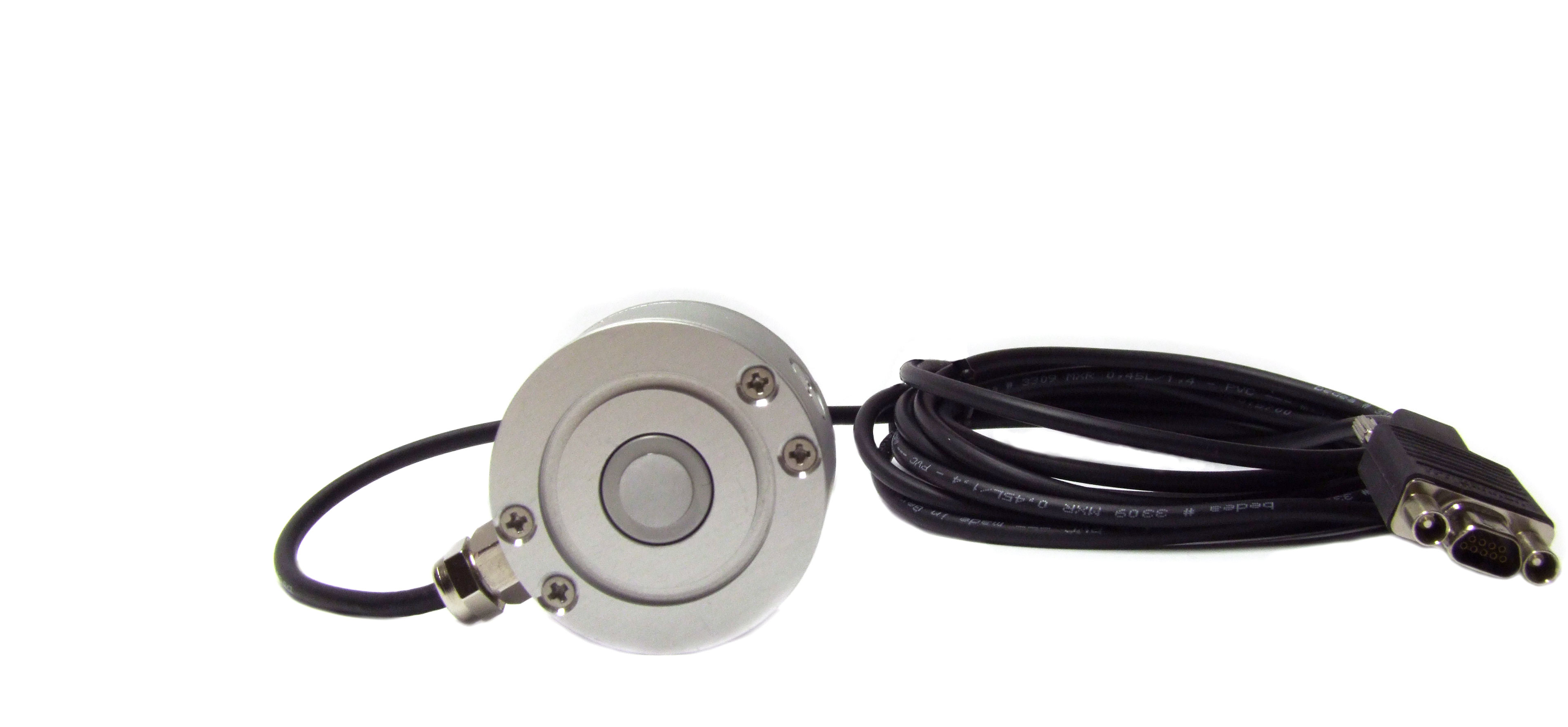
Measurement of Actinic and Safety-Related Irradiance of UV-C Air Disinfection
Measurement of Actinic and Safety-Related Irradiance of UV-C Air Disinfection
UV-C radiation is highly germicidal because it is absorbed by the DNA of microorganisms which destroys its structure. Referred to as ultraviolet germicidal irradiation (UVGI), UV-C wavelengths around (260-270) nm are most effective in combating airborne bacteria, viruses and other microorganisms such as mildews and yeasts. Disinfecting the air can prevent the transmission of a variety of airborne infections such as tuberculosis and pandemic influenza. It can also prevent contamination of raw materials and food. Therefore, UV-C air disinfection systems are being increasingly used within healthcare environments, public places, industry, and research facilities.
Gigahertz Optik GmbH, as a manufacturer of suitable light measurement technology for measuring UV radiation, provides support for both manufacturers and installers of UV air disinfection systems. Manufacturers need to optimise the efficacy of the UV germicidal action of air purification systems whilst ensuring no hazard is presented to occupants. New developments in germicidal UV sources, of particular note are UV-C LED arrays (265-280) nm and far UV lamps such as excimer KrCl (222nm), require new calibration strategies in order to allow low measurement uncertainties. We offer spectral mismatch correction for all used UV sources.
Our specialist UV-C detectors and meters (UVC Radiometers) are designed to withstand the high-energy UV radiation present within air disinfection systems whilst offering the dynamic range to enable low level hazard measurements. To measure the irradiance of such extended sources, radiometers must be designed with a cosine field of view function. The required cosine-correction optics and photodetector components must also be pre-aged because of the high-energy UV radiation. Occupant safety [1] must be ensured for rooms fitted with ceiling-mounted air disinfection systems. The monitoring of exposure to UV-C [2] of long-term occupants (e.g. healthcare workers [3]) within rooms fitted with air purification can be achieved with the use of personal dosimeters such as the X2000 dosimeter. For spectral measurements our high end spectroradiometers like the BTS2048-UV are recommended.
Large Research Project about UV-C Devices
As a contractor of the Federal Office for Radiation Protection in Germany (BfS), we have made extensive measurements in a large study. A total of 41 disinfection devices that work with UV-C radiation were tested. Traceable measurements were performed including measurement uncertainty evaluations according to JCGM 100:2008 and JCGM 101:2008 and a conformity assessment according to ILAC-G8:09/2019. The corresponding risk groups were analyzed according to DIN EN IEC 62471 and evaluation of the framework of DIN/TS 67506 was made. Additionally, some upper air devices were tested according to DIN EN ISO 15858 and finally, DIN EN 60335-2-65 was applied.
A comprehensive report with the measurement data and the framework of product standards and laws was published by the BfS. Further information can also be found in the BfS press release
All measurements were performed with our low stray light BTS2048-UV spectroradiometers with OoR Filter method and combined stray light correction matrix as well as with our UV-37 series detectors.
Related Links:
https://www.gigahertz-optik.com/en-us/products/cat/uvc%20radiometer/
https://www.bfs.de/SharedDocs/Pressemitteilungen/BfS/DE/2024/005.html
https://doris.bfs.de/jspui/handle/urn:nbn:de:0221-2024041943044

64th International Day of Light
Gigahertz Optik GmbH is proud to be part of further light measurement technology
Exactly 64 Years ago, Physicist and Engineer Theodore Maiman conducted the first successful operation of the laser. To cherish this special day in 1960, the International Day of Light is remembered every year on May 16. Gigahertz-Optik is proud to be part of the further developments on laser- and lightmeasurement technology.
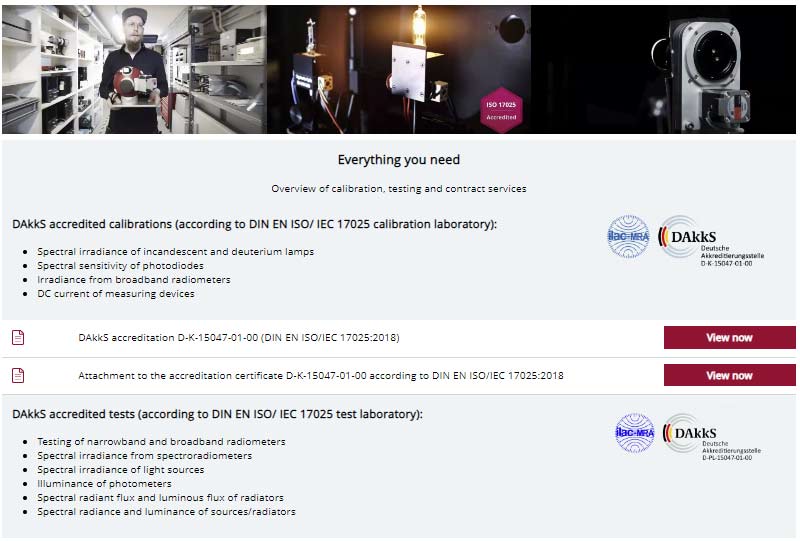
Website Update: Calibration Laboratory
Website Update: Calibration Laboratory
We're happy to announce, that we just have renewed our Calibration Laboratory Site online. Learn more about our skills, services and certifictaions under Calibration Laboratory.
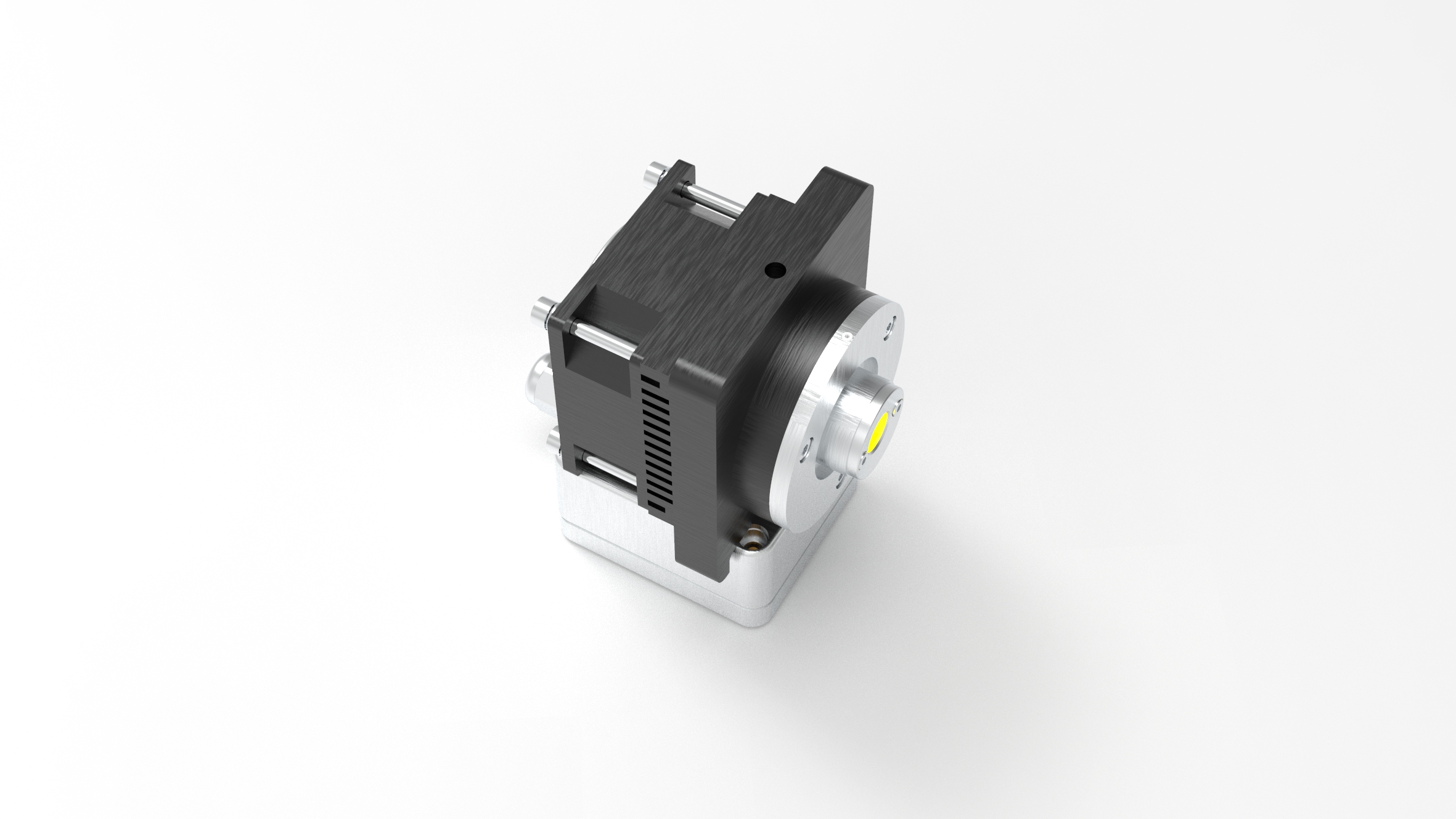
New LED Calibration Standard BN-LLSF-2P to match “CIE Reference Spectrum L41” according to CIE 251:2
New LED Calibration Standard BN-LLSF-2P to match “CIE Reference Spectrum L41” according to CIE 251:2023
In photometry and colorimetry, standard illuminant A light sources have exclusively been used for calibration for decades. Due to the dominant application of LEDs in the field and the fade-out of tungsten lamps as calibration sources, new concepts are needed. With CIE 251:2023 the CIE published in February 2023 a recommendation for an LED reference spectrum named "CIE reference spectrum L41".
The shape of this spectrum is based on available LED illuminant consideration as well as minimum error considerations in terms of spectral mismatch errors of photometers. However, it was not designed to match to an existing LED on the market. The idea of this source is for it to be in addition to standard illuminant A for photometer calibration, especially for LED measurements. The document also states information about typical magnitudes of spectral mismatch errors with V(λ)-filtered photometers in measurements of LEDs as well as other types of light sources. This is done under the assumption that CIE reference spectrum L41 is used for photometer calibration instead of CIE standard illuminant A. Finally, the document introduces a quality metric for selection of white LEDs as physical LED standard sources.
On this basis, Gigahertz-Optik developed the LED-based standard BN-LLSF-2P which is perfectly suited for calibrations of photometers according to document CIE 251:2023 since it is following the CIE reference spectrum L41. The source matches the reference spectrum very well with just minor deviations as indicated by the spectral distribution mismatch index of fsf,L41=0.016. The standard BN-LLSF-2P can be used both as an illuminance calibration standard for photometers as well as a luminous flux standard in combination with an integrating sphere in 2 Pi geometry. The standard is offered together with a calibration by Gigahertz-Optik’s in-house ISO 17025-accredited calibration laboratory, which guarantees highest quality and standards
Spectral distribution of BN-LLSF calibration source compared to CIE reference spectrum L41 (CIE 251:2023)
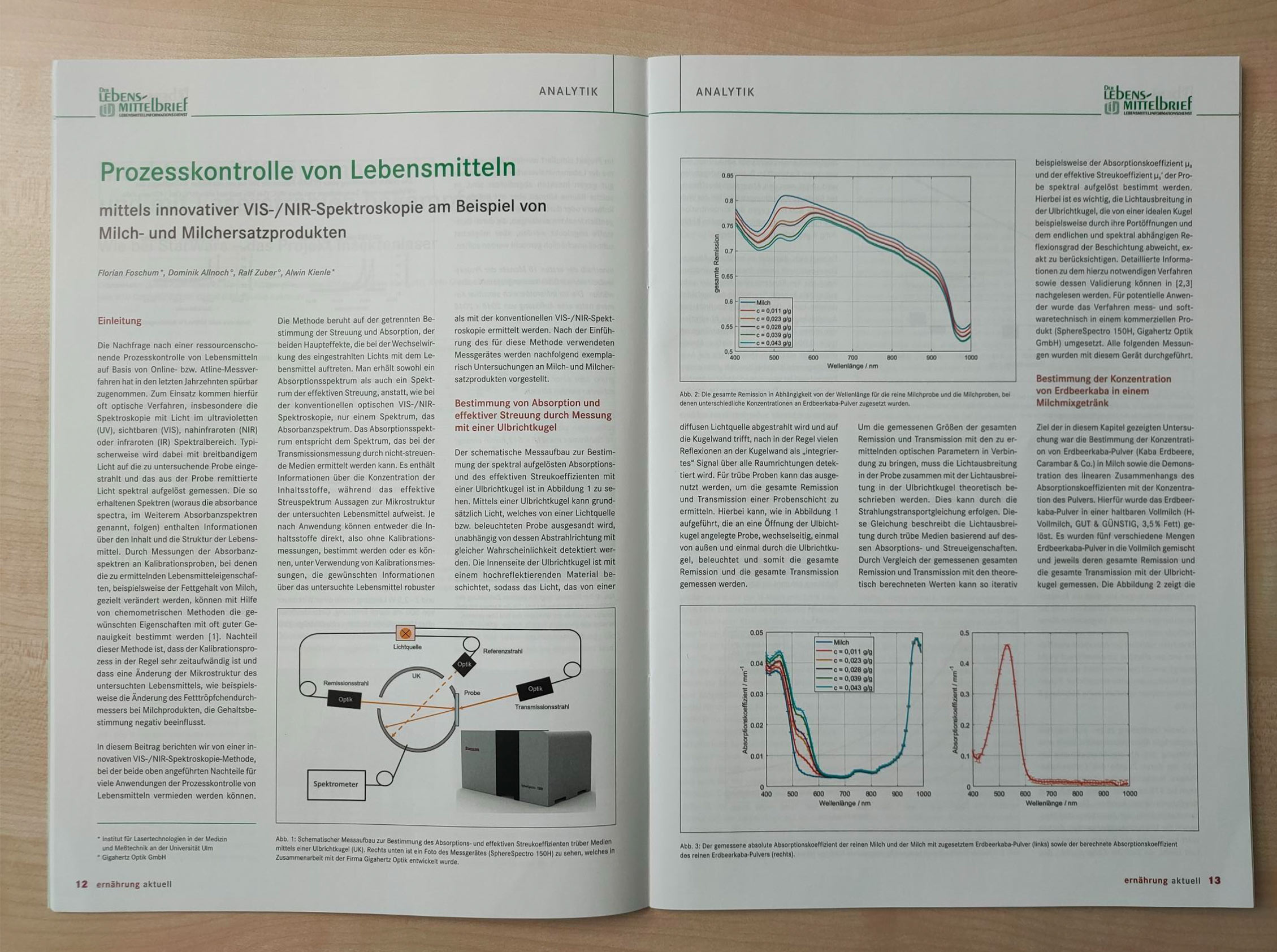
SphereSpectro 150H in trade journal
SphereSpectro 150H in trade journal
Our product, the SphereSpectro 150H, has just been presented in a detailed article in the renowned specialist journal "Ernährung Aktuell". This article was written together with the ILM, which was significantly involved in the development of the spectrometer. We are proud that our hard work and dedication is recognized by our peers and experts. You can find the article attached or you can find it on page 12 of the latest issue of "Ernährung Aktuell", which was published in "Der Lebensmittelbrief".
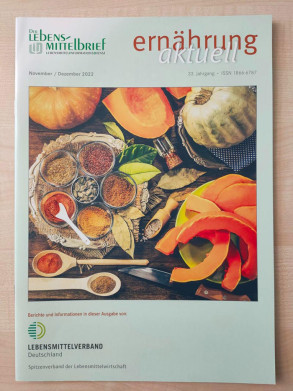
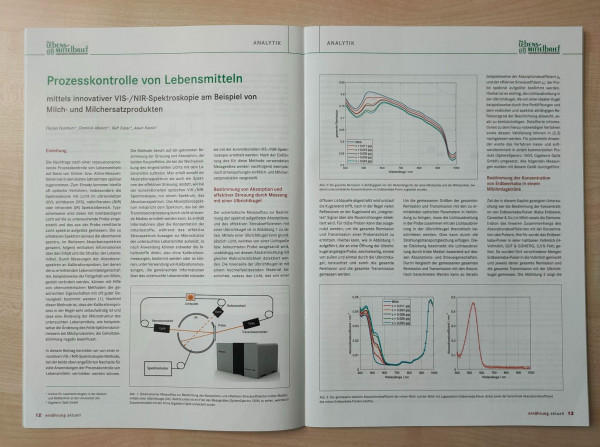
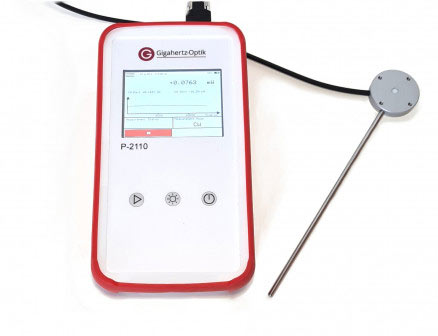
The P-21- A versatile touchscreen optometer
The P-21 from Gigahertz Optik GmbH - A versatile touchscreen optometer for the measurement of CW, single pulse and modulated radiation in all photometric and radiometric applications
With the P-21, Gigahertz-Optik has developed a compact handheld optometer, which is both suitable for field service and equipped with many functions for laboratory use. The successor to the popular P-9710 optometer offers a multifunctional color touch screen and intuitive 3-button menu operation. This allows the user to easily handle and fully concentrate on his measuring task. The P-21 also includes a calibration data port for easy and unlimited replacement of the required detectors. With the following technical data we can support you in your application:
- Measurement of DC, AC, single pulse and modulated radiation.
- Adjustable integration time from 100 µs to 6 s
- Over sixteen different measurement modes and functions
- S-P21 Software & S-SDK-P21 Software Development Kit available
An outstanding feature of the P-21 optometer is its many measurement modes. Detailed information about the P-21 can be found on our website.
https://www.gigahertz-optik.com/de-de/produkt/p-21/
In addition, the P-21 offers many other superb features that make it perfect for various measurement tasks:
- Compact high-precision measuring instrument which is also suitable for field service as well as laboratory use.
- Multifunctional color touchscreen and intuitive 3-button menu operation (Pure touch, mixed touch/button and full touch operation allow to use all functions on the device)
- Calibration data in detector connector for easy detector replacement
- Measurement of DC, AC, single pulse and modulated optical radiation
- 100 µs fast sampling rate
- Adjustable integration time from 100 µs to 6 s
- Wide dynamic range of detector signal from 0.1 pA to 2 mA
- USB interface for remote control operation (additionally RS232 and RS485 available)
- Trigger In/Output via DSUB as well as Analog-Out
- S-P21 software & S-SDK-P21 software development kit available
- Adapter cable available to use P-21 (-5 connector) with P-9710 detectors (-2 connector)
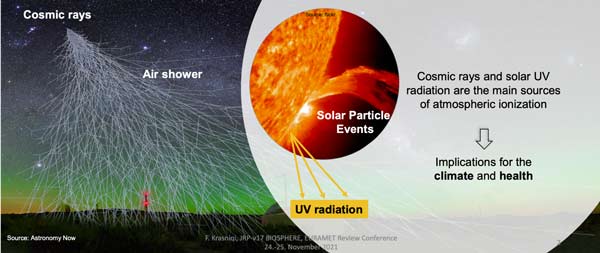
Gigahertz Optik GmbH is pleased to be a partner of EURAMET BIOSPHERE
EURAMET BIOSPHERE
Gigahertz Optik GmbH is pleased to be a partner the new 3-year project EURAMET BIOSPHERE beginning in October 2022.
The project plans to combine observations by modern satellite technologies and ground-based monitoring systems with scientific expertise to study how increased cosmic rays, ultraviolet radiation and the fragility of ozone shield affect the evolution of the biosphere and impacts our health status.
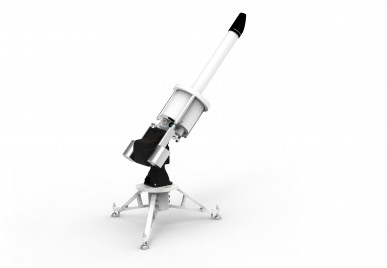
We support the project with a contribution of our BTS-Solar for spectral irradiance measurements to determine for instance the Total Ozone Columen (TOC) in four measurement campaigns!
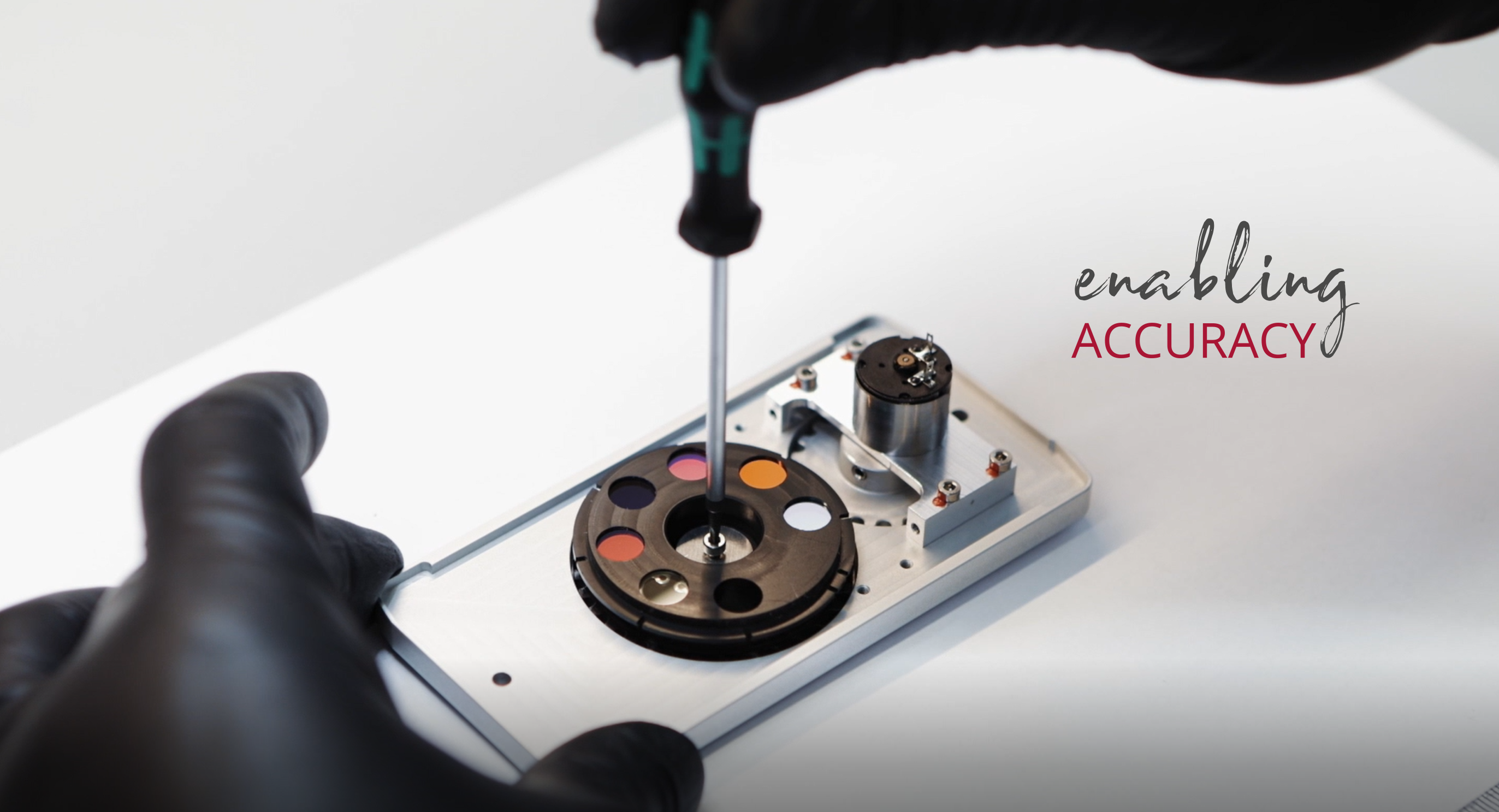
Our Vision: Enabling Accuracy
We, Gigahertz Optik GmbH, have a vision!
Enabling Accuracy
„Gigahertz-Optik enables success in challenging light measurement tasks through smart solutions based on the combination of accuracy, reliability, ease of use, innovation and productivity. We are your worldwide partner in photonics offering UV to IR measurement equipment developed and manufactured in Germany with high-class ISO 17025 calibration laboratory.“
In addition, we are proud to carry the Berghof DNA: MOVING FORWARD
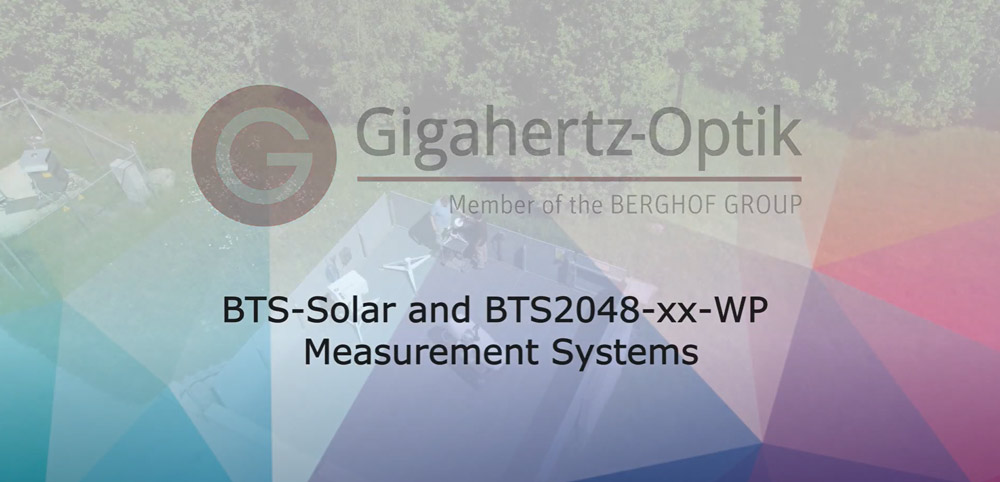
New Video on our Youtube Channel
BTS-Solar and BTS2048-XX-WP in action
In our new short video we show our solar measuring devices in action:
https://www.youtube.com/watch?v=e1lx7BgOdWo
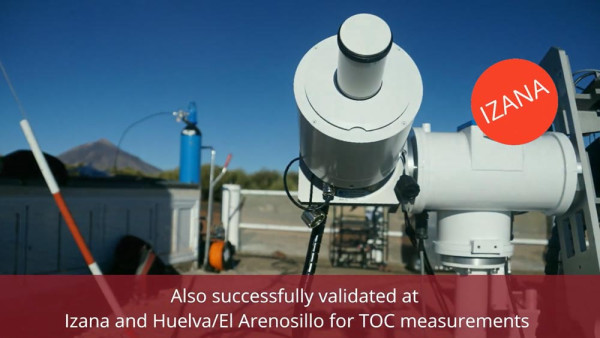
For detailed information on the measuring devices shown, visit the following links BTS2048-UV-S-WP and BTS-Solar
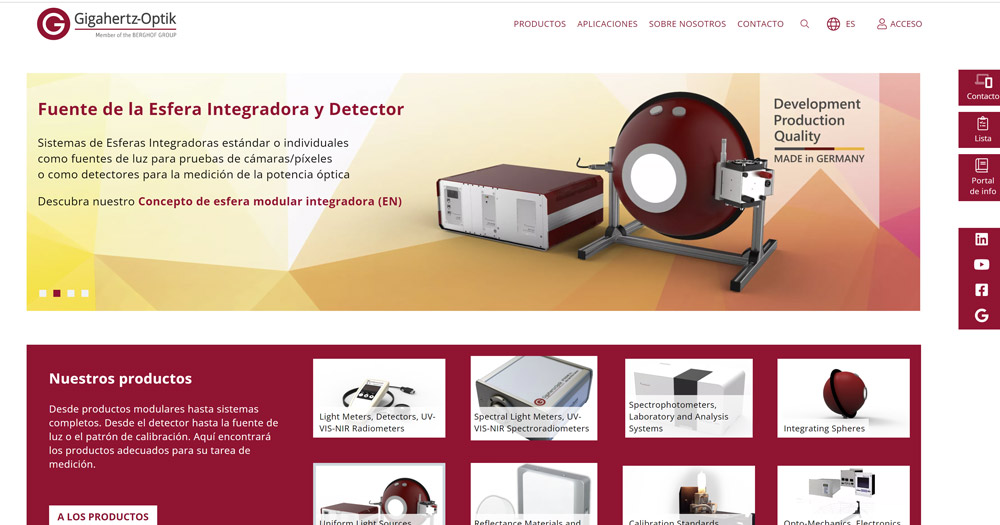
Gigahertz-Optik goes internationally – Discover our website now also in Spanish and Chinese
We are proud of our continued growth enabling greater visibility to customers worldwide. In addition to our German and English language website, it is now also available in Spanish and Chinese. In this way, we offer our customers and sales partners the opportunity to find out more easily about our products and services.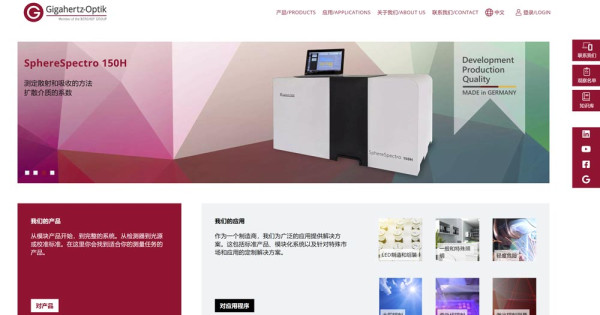
Interested parties from China and Spanish-speaking countries can now access a great deal of information about our extensive product range of light meters, which cover the entire spectral range. Our applications and extensive product news will also reach an even larger target group in the future.
Use this service and find out about our light measurement solutions for your specific application. You can reach our global sales team at sales@gigahertz-optik.com.
We look forward to your ideas. Together we will find a solution to your challenges.
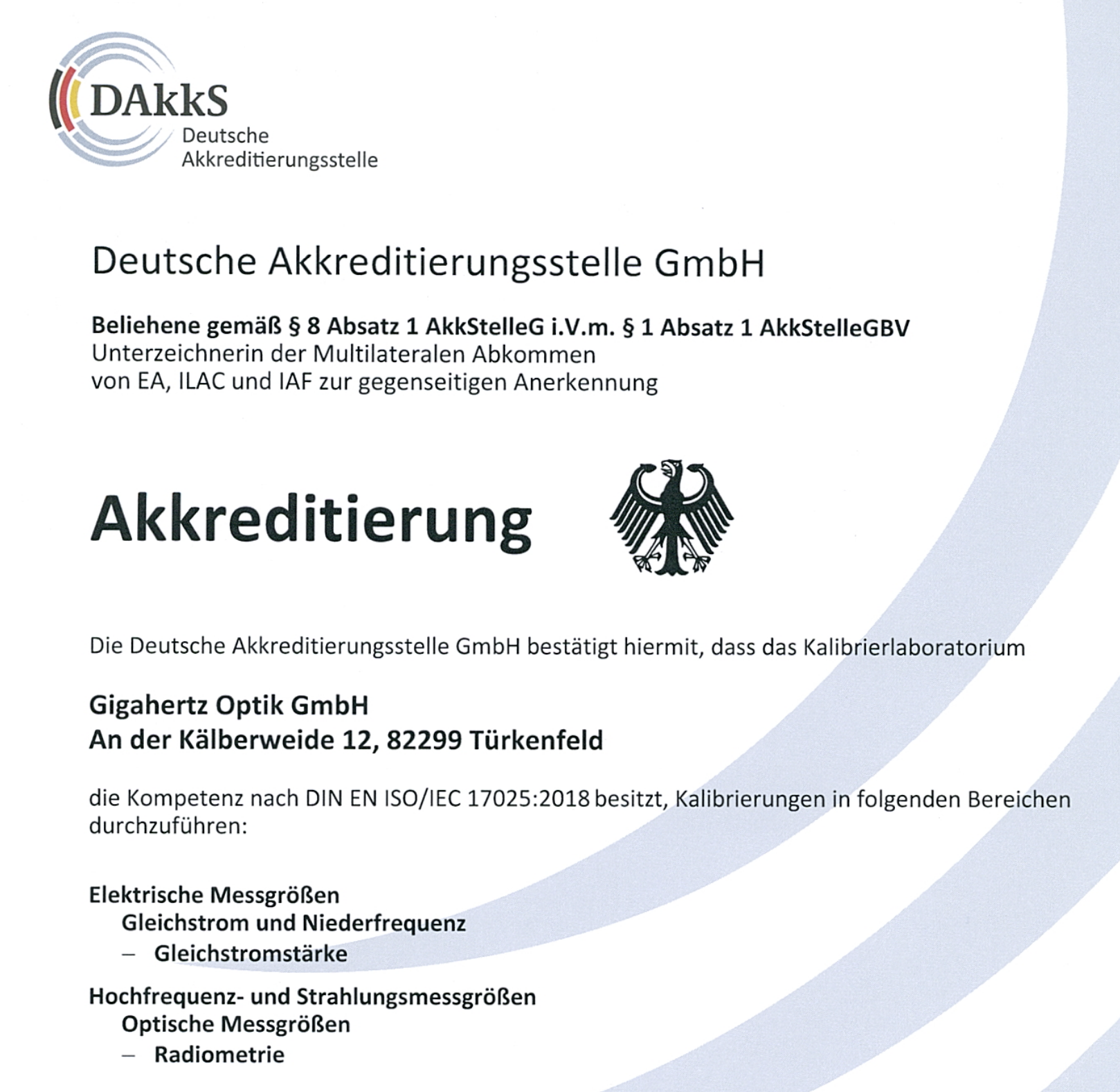
Unique due to the expansion of the calibration laboratory area Gigahertz Optics GmbH
Our new DAkkS accreditation certificate is here
Due to the positive results of the technical and system assessment, our competence was confirmed by the German Accreditation Body (DAkkS) and remains a reliable partner for you for the calibration and testing of your measuring devices.
Not only are the re-accreditations for our testing and calibration laboratory maintained, we have also been able to reduce measurement uncertainties through continuous further development of our processes and procedures. Particularly worth mentioning is the extension of the DAkkS accreditation of our calibration laboratory area.
This enables us to offer you traceable calibrations according to the ISO/IEC17025:2018 standard, which is a globally recognized valid standard.
The new metrics:
〉 Current calibrations (DC current) of indicators / optometers
〉 Spectral irradiance (W/nm) of deuterium lamps (UV in the range 200 nm to 400 nm)
〉 Calibration of the integral irradiance sensitivity of detectors (W/m²) using reference detector and/or spectrometer (BTS2048 series)
The current certificates can be found on our homepage as a .pdf download:
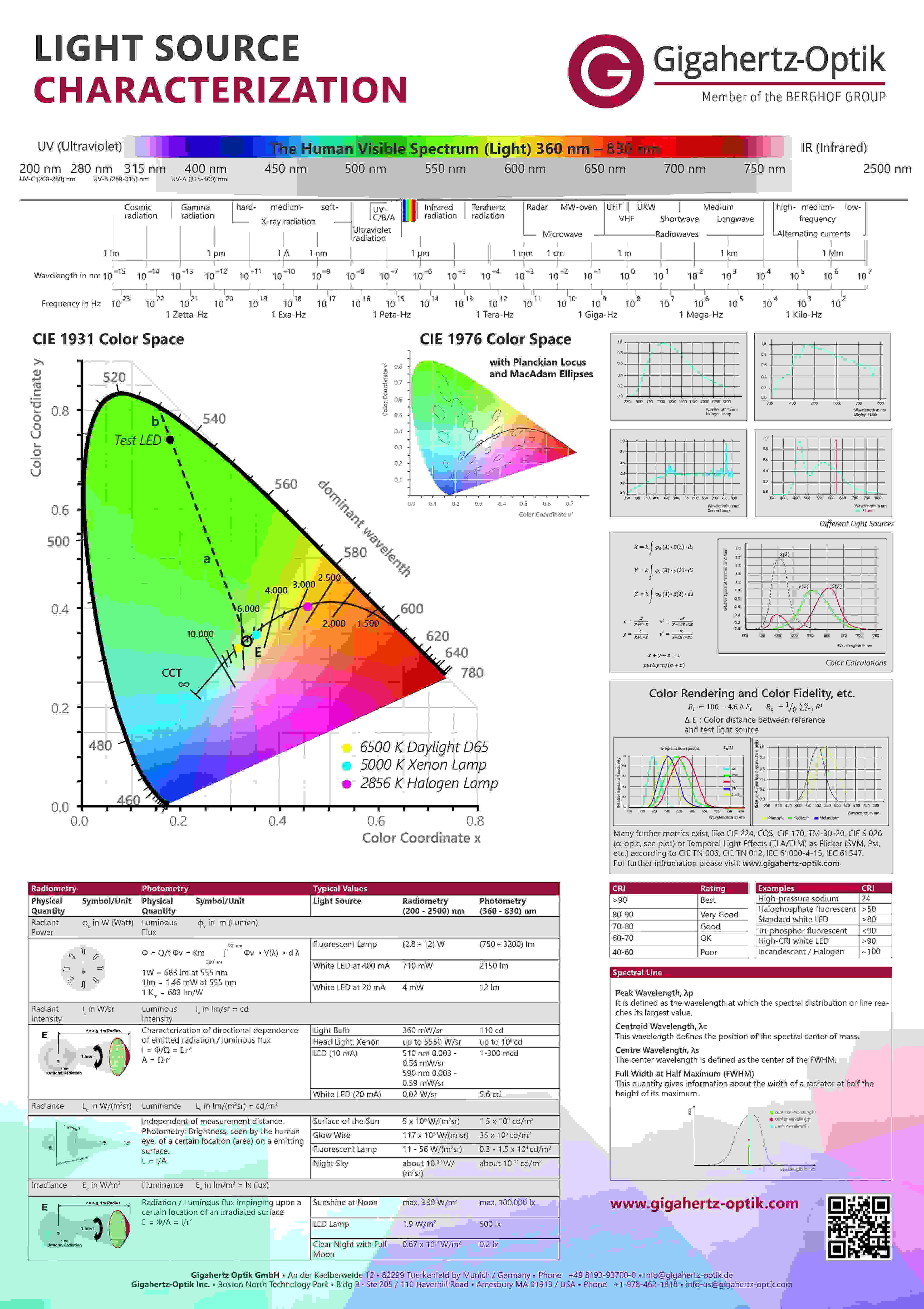
New Light Source Characterization Poster
Our new Light Source Characterization Poster is available for download here.
Here you will find an overview of all the areas of light that we cover with our measuring instruments.
The poster is intended to give you a quick overview of the different light sources and their specific properties.
On request, the posters can also be sent to you in DIN A1 format.
Simply fill out the contact form.
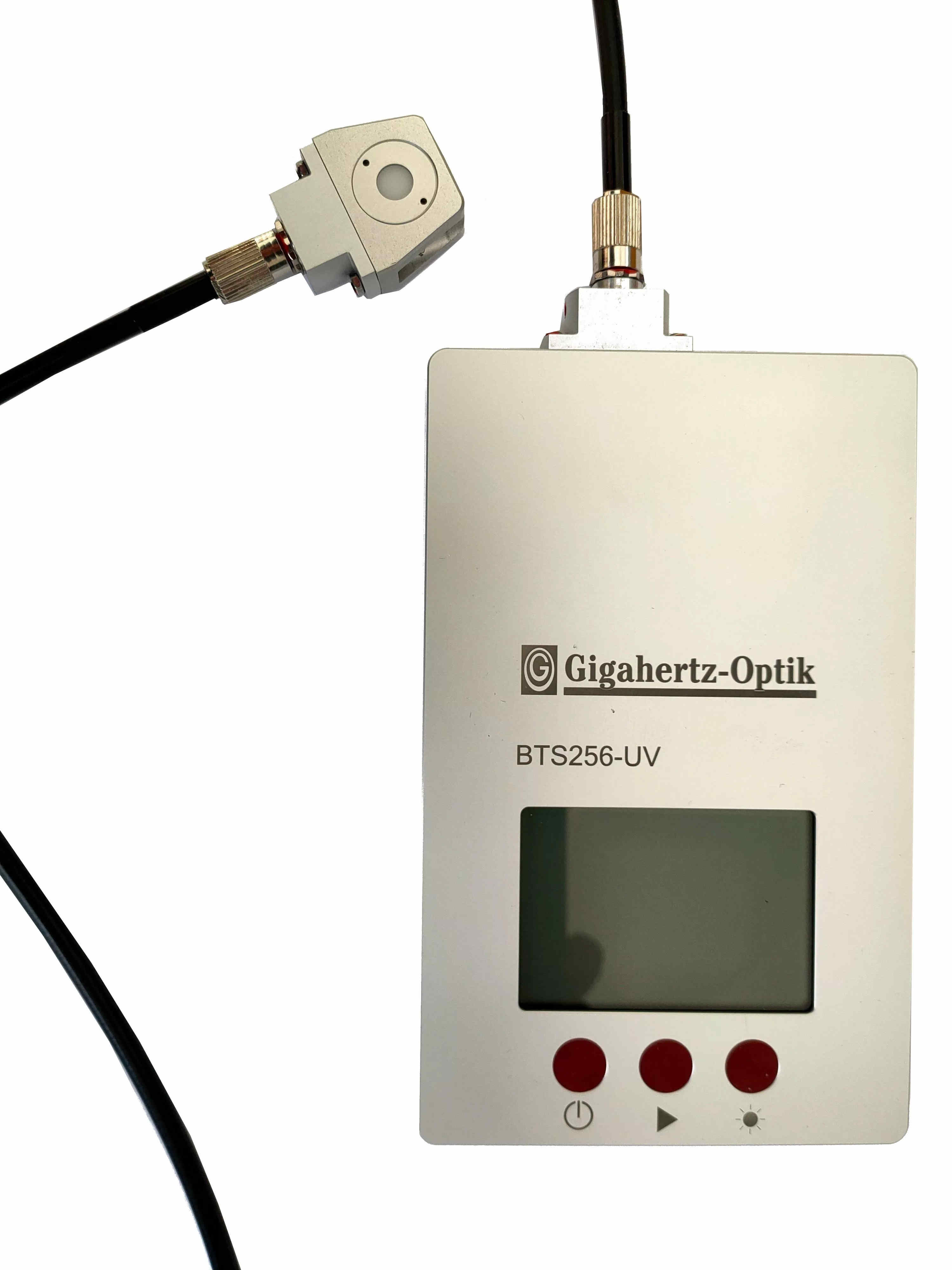
BTS256-UV Spectroradiometer for IEC 61215 series preconditioning tests of PV modules
The qualification of PV modules according to IEC 61215 series requires preconditioning with defined doses of UVA and UVB radiation. Unlike conventional radiometers, the new BTS256-UV spectroradiometer enables the most accurate measurement of UVA and UVB irradiance levels irrespective of the type of UV source used. Each device is supplied with a traceable calibration certificate and is designed to operate at the required high temperature.
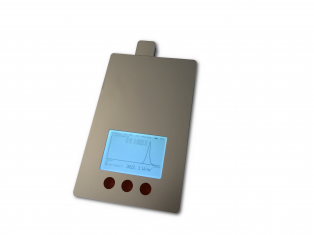
BTS256-UV-2 Flow meter for use on conveyor belts
The BTS256-UV measures the spectral irradiance produced by UV preconditioning systems over the spectral range 280 nm to 400 nm. This enables the most accurate determination of the absolute proportions of UVA and UVB radiation. Incorporation within automated systems is made possible via the RS-485 serial interface with the software Read-out Kit, S-SRK-BTS256. This enables control of the UV radiation system and ensures an appropriate dose of UVB radiation within a total UV prescribed dose of 15 kWh/m2. The full measurement data are available via the user application software or the Read-out Kit.
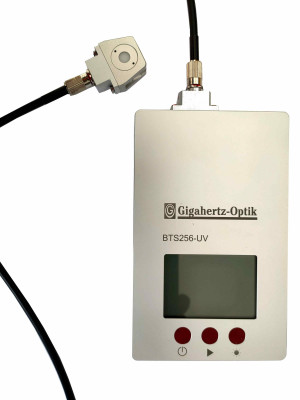
BTS256-UV-4 with fiber adapter and cos-diffuser
The BTS256-UV spectroradiometer is built into a stainless steel housing that has excellent UV stability and low thermal conductivity providing reliable operation at the obligatory temperature of 60°C±5°C. Its thin construction and integrated cosine diffuser ensure correct measurement of irradiance in the required plane.
The calibration laboratory at Gigahertz-Optik offers factory calibrations for the BTS256-UV with the highest level of traceability. They are subject to the same quality management as used in Gigahertz-Optik’s DAkkS-accredited calibration and testing laboratory. ISO 17025 accredited test certificates of calibration for the BTS256-UV are optionally available.
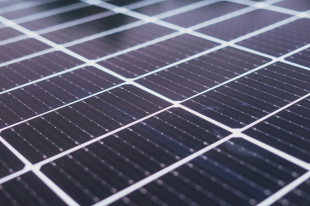
Photovoltaic system - Photo by Los Muertos Crew -Pexels
The BTS256-UV spectroradiometer covers the spectral range 200 nm to 520nm and is therefore suitable for other high intensity UV applications including UV curing, solar simulation, UV weathering systems, and germicidal UV radiation.
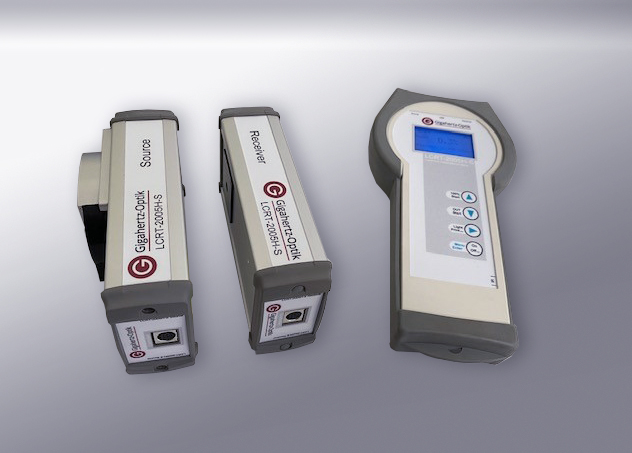
New hand-held measuring device LCRT-2005H-S for spectral transmission and haze
Transparent materials are essential in many branches of industry, such as for the glazing of buildings or vehicles. In the case of packaging, the films used should on the one hand ensure the safe packaging and storage of food and other products. On the other hand, they should also offer a view of the product. The requirements are diverse and plentiful.
For example, the protective screens of smartphone displays, laptops or tablets should offer a good view of the information displayed while at the same time reducing glare from ambient light by minimizing haze effects. With the LCRT-2005H-S , Gigahertz-Optik offers the ideal measuring device for examining these optical material properties.
On the one hand, the LCRT-2005H-S offers the possibility of carrying out spectral transmission measurements on transparent materials according to CIE 130 and DIN 5036. Compared to its predecessor LCRT-2005-S, it offers an extended spectral range from 380 nm to 780 nm (previously 425 nm to 705 nm) and a transmission measuring range from 5% to 100%. On the other hand, the LCRT-2005H-S is equipped with a light trap that enables spectral haze measurements according to ASTM D1003-13 to be carried out.
The device offers operating modes both as a mobile hand-held measuring device and as a wired remote controlled unit that communicates with a PC. A selection of mechanical setups and mounts including sample attachment are available as accessories.
Additional information about the product and its accessories is found in the following data sheets:
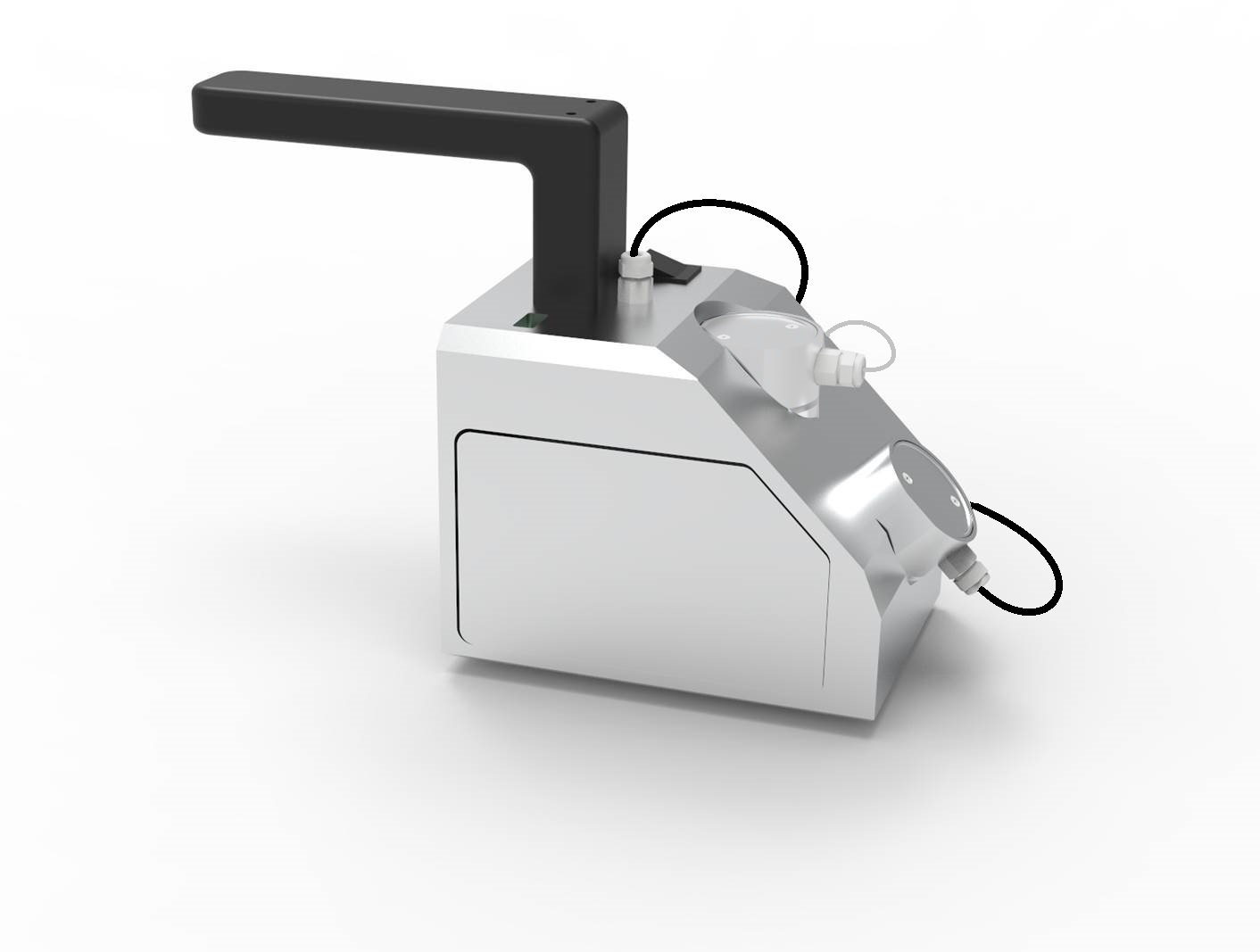
LCR-20 UVC Reflectometer
Measures Diffuse & Specular Surface Reflectance In Situ
The LCR-20/LCR-21 is designed to measure UV reflection of surfaces in the UVC spectral range. 45° and 0° measurement geometry settings are possible.
The battery operated LCR-20/LCR-21 employs a collimated UVC LED based source with a reference detector to monitor and correct UV output fluctuations and a UV-37xx detector that connects to a customized X1 meter for readout of reflectance values.
Recalibration in the field is possible using an ODM reference standard for calibration at 45°/0° (diffuse reflectance), For 45°/45° (specular reflectance) a UV-enhanced mirror can be supplied optionally.
The International Ultraviolet Association recently announced the LCR-20/LCR-21 has earned its UV Product Innovation award for 2021. The IUVA awards recognize achievement in UV innovative technology.
The LCR-20 is a unique and much needed tool for use in UVC disinfection applications. It provides a means to measure UVC surface reflectance, both specular and diffuse, on site. This information is needed for accurate modeling of expected UVGI (ultraviolet germicidal irradiation) levels within a space.
Gigahertz-OptikGmbH which has been in business since 1986 and joined the Berghof Group in 2020, specializes in the development, production, calibration and distribution of optical radiation measurement equipment with expertise in the entire optical spectral range from ultraviolet (UV) to infrared (IR). The company has a reputation for taking on custom projects, the results of which often become part of its wide range of standard products that includes a variety of light measurement products for optical radiation, as well as materials and coatings, light sources and accessories.
In describing the genesis of the LCR-20 UV Reflectance Meter, Bob Angelo, managing director for Gigahertz-Optik Inc., the company's subsidiary in the US, explained that a leading UV light source manufacturer approached the company with a request to design a field portable UVC surface reflectance meter. The need for this type of tool was shared by Gigahertz-Optik company clients that were involved in the software modeling of upper room UVGI surface reflectance values.
The LCR-20/LCR-21 system components include the Gigahertz-Optik UV-3725 detector head sensor which attaches to the LCR-20, a UV LED collimated light source that, in turn, connects to its X1-5 Optometer to control the devices and display operational and measurement data.
"The LCR-20/LCR-21 is the only currently available UVC reflectance meter that can measure surfaces in situ," said Angelo. "Until now, samples of the surface material needed to be taken to the lab and measured on a floor-based spectrophotometer. Typically, a small sample of surface material needed to be cut to fit into the sample chamber of the spectrophotometer." The ability to take the meter to the site of the surfaces is a huge improvement over having to extract a portion of all relevant surfaces to take to the meter in a lab.
To create a meter suitable for use on different types of walls, counters and ceiling surfaces, Gigahertz-Optik engineered and fine tuned the meter's requirements for spectra, operation, measurement geometry (45 degree/0 degree for diffuse reflectance and 45 degree/45/degree for specular reflectance), measurement uncertainty and reference standards. Future versions of the meter will include an expansion of its spectral capability beyond 254nm.
Angelo described a scenario in which the LCR-20, UV-3725 and X1-5 can be used. "UVC fixtures employing low pressure Hg lamps are being installed in a hospital ward. The UVC output is to be mapped using modeling software to ensure there is sufficient UVGI being delivered as uniformly as possible across the upper room, and UV health hazard risks also must be assessed to ensure occupant safety."
So to complete the computer modeling the UV germicidal irradiance and UV hazard risk need to be measured as well as the UV reflectance. This can be accomplished by adding an extra UV-3725 detector for use with the X1-5 meter. A UVGI survey kit is available to complete all of these measurement requirements.
Link to Article: Innovation Column: UV Reflectance Meter
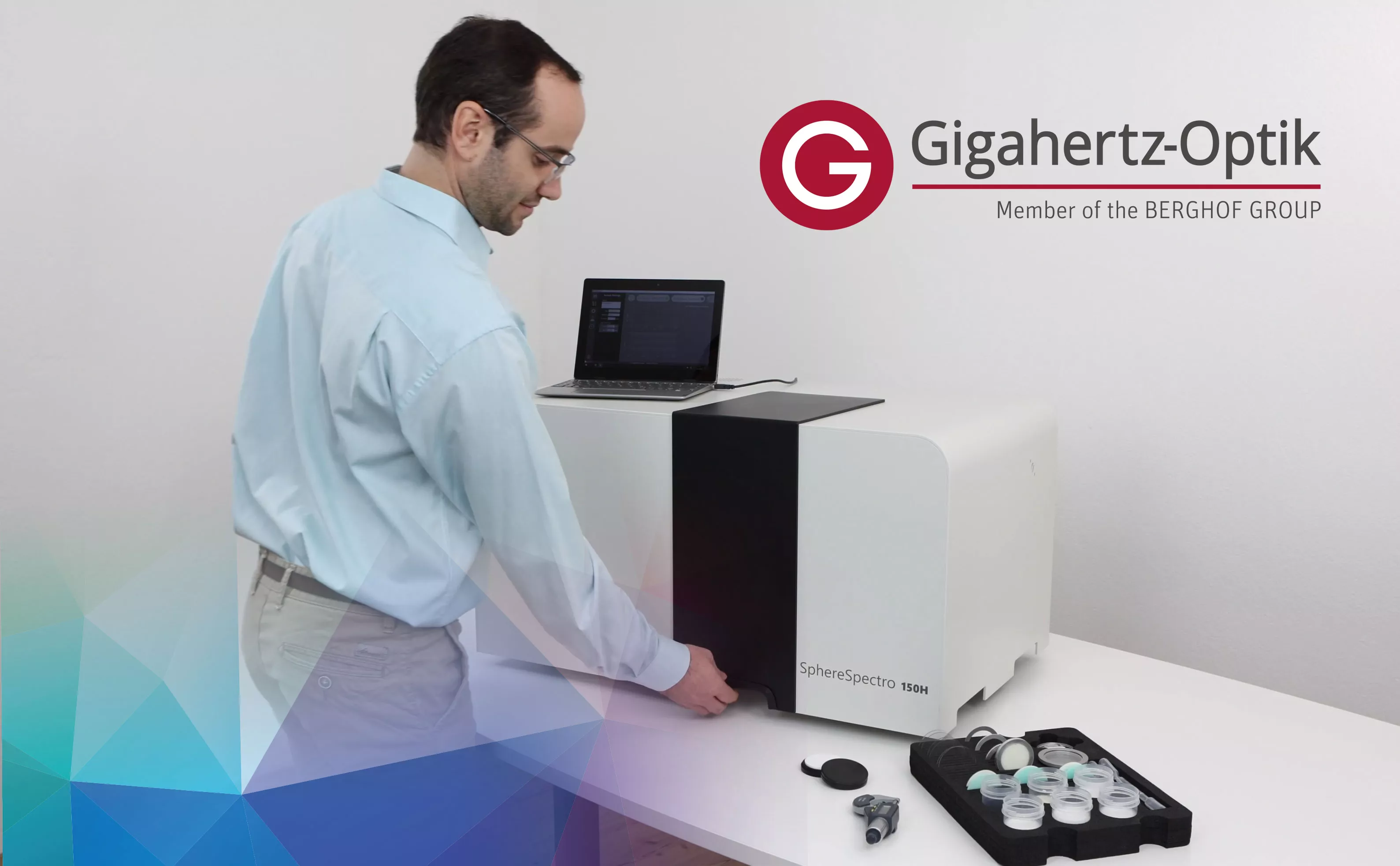
Evaluation of the aging behavior of metalworking fluids
Metalworking fluids are commonly used to cool and lubricate metal workpieces during machining to reduce heat and friction. Due to evaporation, erosion, or bacterial decomposition/modification, the properties of the cooling lubricant also change over time, affecting the operation of the machines or the quality of the metal workpieces. Extending the life of a cooling lubricant is desirable from both economic and environmental perspectives. Knowledge of the effects of processing conditions on aging behavior and reliable analytical methods are required to characterize aging phenomena. To date, no quantitative estimates of aging effects on cooling lubricants have been described in the literature. Only univariate estimates based on single parameter measurements, such as pH alone, exist.
In cooperation with partners (Reutlingen University, the University of Tübingen, the University of Natural Resources and Applied Life Sciences (Vienna) and the company Festo SE & Co. KG), a scientific study was published in which the intuitive SphereSpectro 150H spectrophotometer system from Gigahertz Optik GmbH was used for the simultaneous metrological monitoring of three quality parameters of cooling lubricants and a mathematical model was developed for the evaluation. This model can be used to infer the cooling lubricant concentration, the droplet size and the pH value. These parameters are relevant for predicting the service life of the cooling lubricant. By knowing each of these parameters, adjustments can be made in the process to optimize the longevity of the coolant. Detailed information can be found in the scientific paper: https://www.mdpi.com/1424-8220/21/24/8299
With the SphereSpectro 150H, the optical material properties, i.e. the spectral absorption coefficient and the spectral effective scattering coefficient, can be determined simultaneously and separately from each other - something that has not been possible up to now with conventional measuring systems. For the measurement, the samples are placed directly into a cuvette and measured with the SphereSpectro 150H without further sample preparation.
In this case, only one measuring system can replace conventional and separate measuring methods, such as dynamic light scattering measurement, turbidity measurement or various spectroscopic measuring methods such as electrochemical impedance, Raman or fluorescence spectroscopy. Measurement errors caused by tramp oil, for example, can also be considered when measuring with the SphereSpectro 150H. The intuitive operation of the SphereSpectro 150H does not require specially trained personnel.
With this first feasibility study we have shown what is technically possible. If you are interested or have a similar application, we look forward to hearing from you.
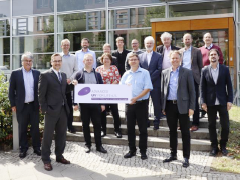
Gigahertz is a founding member of"Advanced UV for Life e.V. - Association for the Promotion of UV S
BERLIN 09.09.2021 | UV technologies can be used in a variety of ways and open up opportunities for innovative and environmentally friendly solutions. In times of the corona pandemic, it becomes particularly clear what contribution you can make. The association "Advanced UV for Life e.V. - Association for the Promotion of UV Semiconductor Technologies" has therefore committed itself to the goal of promoting such technological solutions quickly and transferring them from research to application.
Small radiation source - great variety of applications
With light-emitting diodes (LEDs) that emit ultraviolet (UV) radiation, surfaces, air and water can be disinfected quickly, environmentally friendly and without chemicals. Corona viruses and other pathogens such as multi-resistant germs can also be inactivated with it. Another advantage of UV LEDs is that the emitted wavelength can be set between 210 and 400 nanometers. This opens up many other possible uses, for example for medical prevention and for diagnosing and treating diseases. They are also used for the rapid hardening of composite materials, adhesives and paints as well as in environmental analysis, sensor technology and in the life sciences.
Although UV LEDs are already used in many applications, there is still a significant need for research and technology development. Close coordination between the component developers and the end users in the various areas of application is a prerequisite for the rapid implementation of innovative ideas. Legal regulations and standards for the use of the new components and technologies are decisive for market access.
Develop faster through a competent network
The now founded association "Advanced UV for Life e.V." bundles competencies from business and science along the entire value chain - from the concept to the UV semiconductor to its application. This is also reflected in the list of founding members. The association builds on the eight years of experience of the consortium of the same name, which was funded by the Federal Ministry of Education and Research as part of the Zwanzig20 program.
"The aim is to promote and accelerate the technical development of UV radiation sources and UV sensors, in particular LEDs, photodiodes and laser diodes, and their use," says Prof. Dr. Michael Kneissl. He is chairman of the board of the association, whose office is located at the Ferdinand Braun Institute in Berlin. The association creates the communication and cooperation platform to discuss technological and scientific questions and to initiate development projects and research projects.
In order for environmentally friendly and economical UV technologies to gain broad acceptance, the association wants to provide the population, politics and the media with comprehensive information on the new products and services. He also participates in specialist bodies and committees to bring legal provisions, standards and other regulations into motion.
In addition to Prof. Dr. Michael Kneissl (Technical University Berlin and Ferdinand Braun Institute) as chairman, Prof. Dr. Michael Heuken (AIXTRON SE), Dr. Martin Strasbourg (OSRAM Opto Semiconductors GmbH), Dipl.-Ing. Thomas Westerhoff (Fraunhofer Society) and Dr. Olaf Brodersen (CiS Research Institute for Microsensorics GmbH) elected. The board of directors is supported by an internal advisory board of nine members who, as specialists, represent the various fields of work.
To be there!
With the establishment of the association, the association invites companies and research institutions, idea generators and experts, UV enthusiasts and networkers to jointly build a powerful association, to think outside the box and to advance new UV technologies together more quickly. All companies and scientific institutions active in this field as well as interested individuals can become members. Further information on membership in the association can be found on the website https://www.advanced-uv.de/verein.
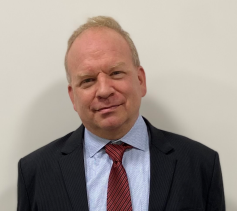
Introducing Jim Litynski, Business Development Manager in the US
| Jim Litynski Business Development Manager US | |
| We take great pleasure in welcoming Jim Litynski, as Gigahertz-Optik Inc Business Development Manager based in the Amesbury, MA USA subsidiary office. Jim comes to us with extensive experience in technical sales and management with a background in Physics and Optics. His previous roles included Key Account Manager of Dexter Magnetics, Regional Sales Manager of Celera Motion and President of the US subsidiary of Piezosystem Jena GmbH. Jim has a B.S. in Physics from Rensselaer Polytechnic Institute. | |
| Gigahertz Optik GmbH An der Kaelberweide 12, 82299 Tuerkenfeld, Germany Gigahertz-Optik Inc. | Contact Jim Litynski Phone 978-462-1818 j.litynski@gigahertz-optik.com |
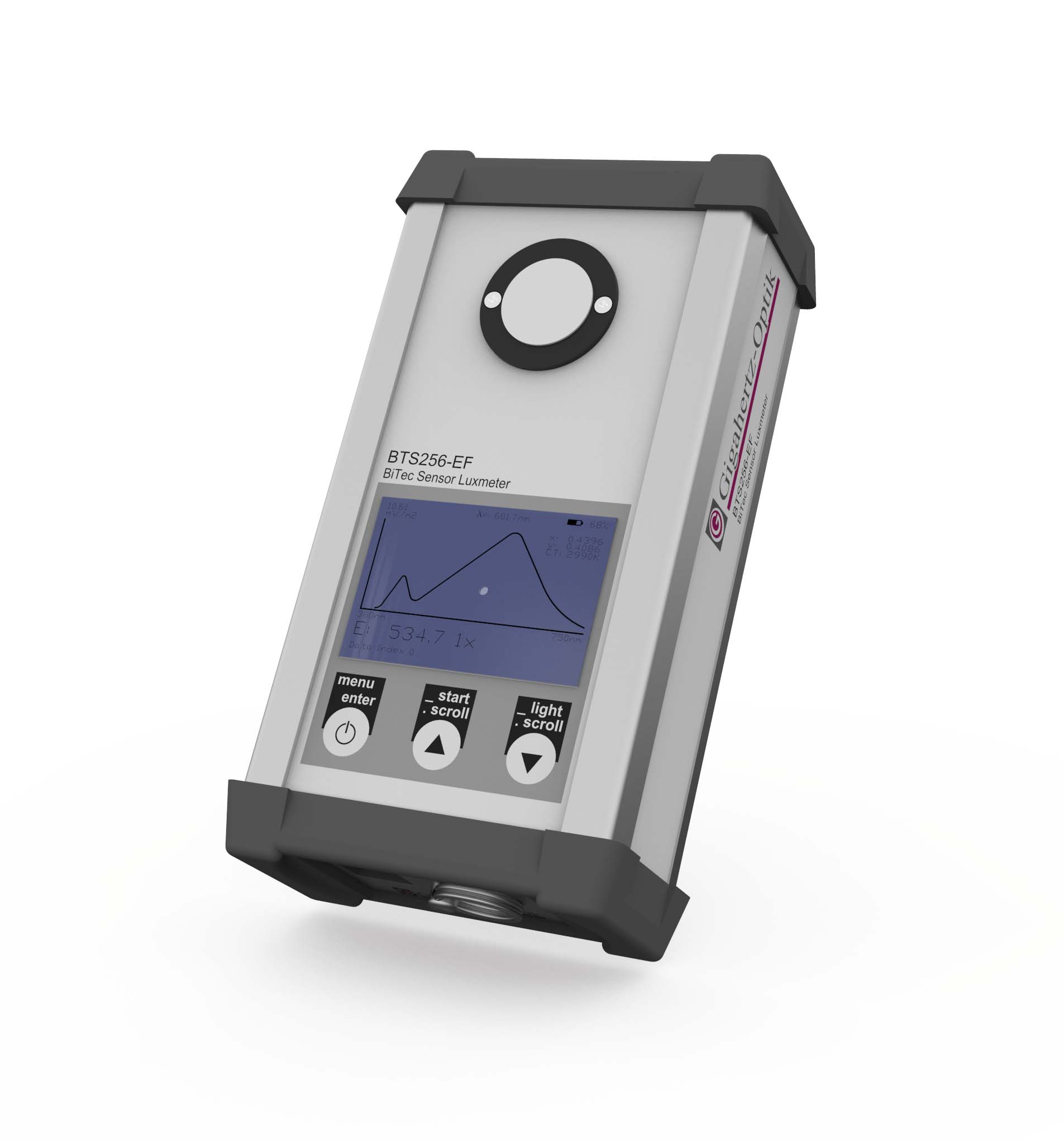
Enhanced BTS256-EF accurately measures flicker and SVM as required by Ecodesign Regulation
The European Commission´s Ecodesign Regulation for light sources and separate control gear came into force on 1st September 2021. It imposes limits on functional requirements including the regulation of flicker and stroboscopic effects. The BTS256-EF spectral light and flicker meter now offers 200 kHz sampling rate enabling high accuracy measurement of PstLM and SVM for LED driver circuitry employing high frequency modulation.
The Ecodesign Regulation, also known as the Single Lighting Regulation (SLR), was revised in February 2021 to include mandatory limits of PstLM < 1.0 for flicker and SVM < 0.9 for stroboscopic effects. These hard limits mean that measurement uncertainty can have significant consequences for manufacturers. The SVM limit is expected to be further reduced to < 0.4, probably in 2024.
The enhanced BTS256-EF is particularly advantageous for those needing to measure LED drivers that use driving frequencies of 2 kHz or more with a duty cycle of 10% or less and also when the modulation signal contains high frequency components. This is the case for example when very short, so-called ‘Dirac pulses’, are used as they comprise many high frequency components.
Besides full flicker and stroboscopic measures, the BTS256-EF provides comprehensive photometric and colorimetric data required for general lighting applications. Additional functions are also provided for specialist tasks such as horticultural and human centric lighting. These versatile spectral light and flicker meters are calibrated in Gigahertz Optik’s ISO 17025 accredited laboratory.
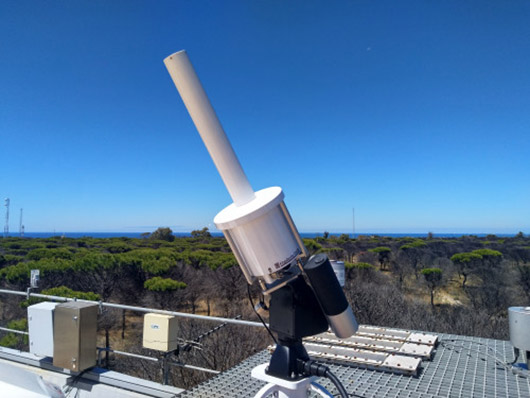
BTS-Solar system validated for total ozone column (TOC) in two long term studies.
BTS-Solar system validated for total ozone column (TOC) in two long term studies.
The performance of Gigahertz Optik’s BTS array-spectroradiometer-based systems configured for the determination of total ozone column (TOC) has been validated in two long term studies. Results have been compared with the well-established Dobson and Brewer spectrometers (single- and double-monochromator types) over a period of more than 1 year.
One study was conducted by the Deutscher Wetterdienst (DWD) in Hohenpeißenberg, Germany using Gigahertz Optik’s turnkey BTS-Solar system. The other study was performed by the Physikalisch-Meteorologisches Observatorium (PMOD/WRC) in Davos, Switzerland using a system based on the fibre coupled BTS2048-UV-S-F spectroradiometer.
Both systems used TOC retrieval algorithms based on spectral measurements in the range of 305 to 350 nm instead of single-wavelength or wavelength pair measurements as per Brewer or Dobson. However, they used fundamentally different retrieval algorithms for the TOC assessment. Overall, the BTS-Solar performed at the level of Brewers in the comparison, thereby offering a convenient, contemporary and cost-effective alternative to the traditional Dobson and Brewer spectrophotometers that have been in use since the 1920s and 1980s, respectively.
See our full range of spectroradiometers for solar radiation applications.
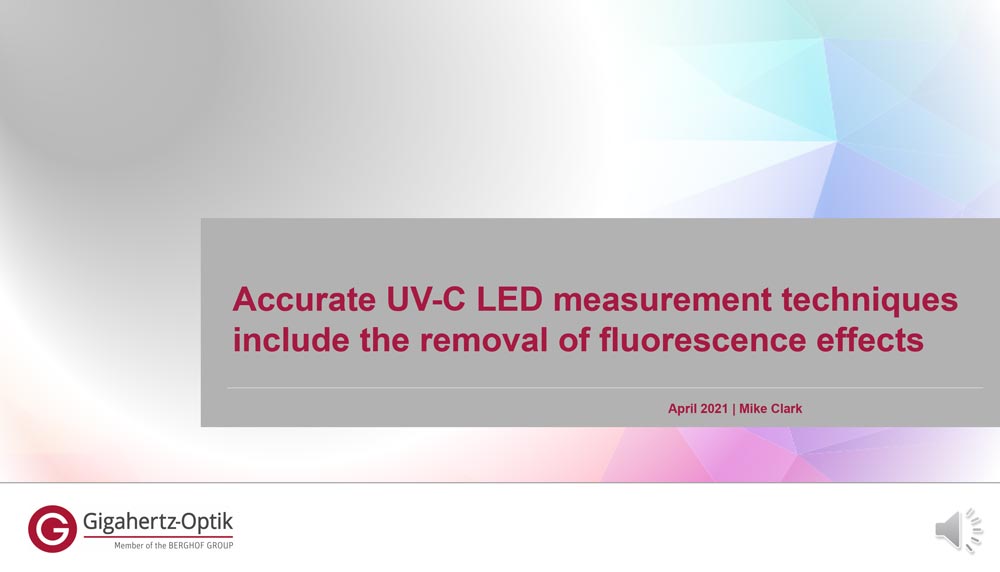
Gigahertz Optik gives talks at two international UV conferences
Gigahertz Optik has recently presented talks at two international conferences on UVC radiation. Both presentations are now available for post-event viewing using the following links.
At the International Ultraviolet Association’s IUVA 2021 World Congress, Gigahertz Optik’s talk “Far-UVC germicidal sources – measurement challenges and solutions” addressed the demands placed on equipment and techniques for the accurate measurement of germicidal UVC sources and in particular, far-UVC such as excimer 222nm lamps.
At the International Conference on UV LED Technologies & Applications, ICULTA 2021, the presentation “Accurate UV-C LED measurement techniques include the removal of fluorescence effects” explored the importance of considering fluorescence effects as a potential source of significant error when measuring UVC LEDs.
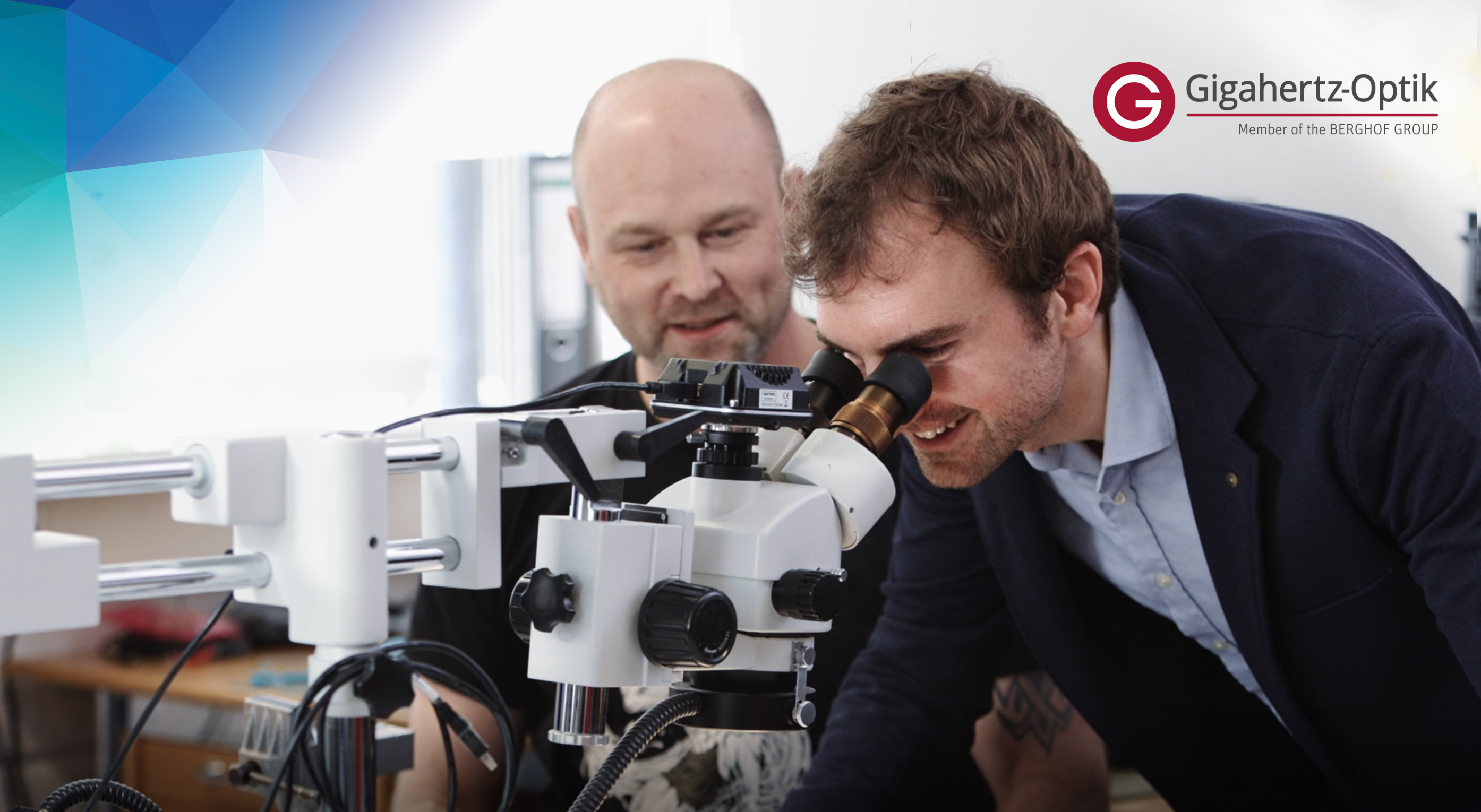
New: Watch our Gigahertz Optik Company Video
Light accompanies our everyday life in the most varied of facets. The most diverse applications in the UV-VIS-IR spectrum require light sources or measuring systems to optimize the well-being of people in rooms, to promote self-sufficient plant growth, to advance future technologies in autonomous driving and much more. Thanks to our DAkkS accredited testing and calibration laboratory (ISO / IEC 17025 / DAkkS D-K-15047-01-00, DAkkS D-PL-15047-01-00), our measuring devices deliver high-precision measurement results that our customers benefit from in their applications. We develop, produce and calibrate our product solutions at Türkenfeld, near Munich.
In our new company video you have the opportunity to get an overview of our services, products and the people who are behind all the product developments with "Made in Germany" quality.

New product available
The SphereSpectro 150H - UV-VIS-IR spectrophotometer
Shortens the working time in your measurement application and delivers high-precision, absolute measurement results.
Measures the spectral absorption coefficient (µa) and the spectral, effective scattering coefficients (µs - also called reduced scattering coefficient) of diffuse and clear samples, regardless of whether they are solid or liquid.
The table-top device has a large sample space with a clamp holder, which makes inserting the samples just as easy as evaluating them on the screen. An intuitive software package is provided to enable you to "plug & play" evaluation of your scattered or clear media in a matter of seconds.
Ideally suited for material analysis, biophotonics, content determination as well as quality assurance, food analysis, pharmacy or cosmetics.
We recommend this video to give you a quick insight into the innovative technology for the simultaneous determination of the scattering and absorption of a volumetric sample.
For more product Information about the SphereSpectro 150H please follow this link.
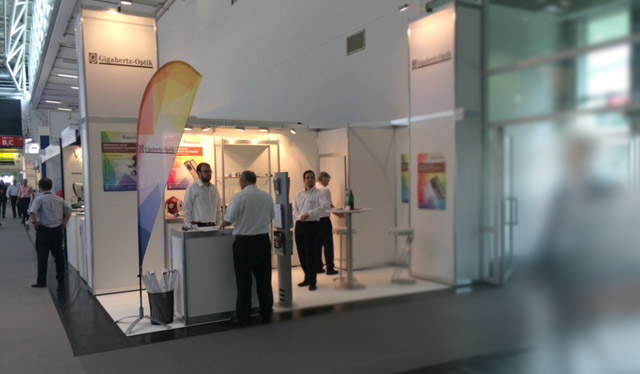
Gigahertz Optik at German Pavilon at LASER CHINA 2021
Gigahertz Optik GmbH will be represented at the "German Pavilion" from March 17th to 19th, 2021 of the LASER World of PHOTONICS CHINA 2021. With current solutions in light, laser and UV measurement technology, we are looking forward to getting in touch with you and discussing your problem.
UVC Radiometer
Learn more about our UVC radiometers for measuring irradiance (µW / cm²) and dose (mJ / cm²) of germicidal lamps, including Hg, excimer and xenon lamps as well as UV-C LEDs.
ISD-1.6-SP – Laser detector
Detector for the fast, time-resolved (ns) radiant power measurement of pulsed laser diodes and LEDs.
The SphereSpectro 150H
UV-VIS-IR spectrophotometer for the separate and simultaneous determination of the spectral absorption coefficient as well as the spectral effective scattering coefficient of solid and liquid samples.
For general informations about our light measurement product range follow this link to our brochure – „Measurement Solutions for general and specialized lighting“.
WE thank you for your interest and are happy to answer your questions at info@gigahertz-optik.de or
via phone on + 49 08193 93 700-0.
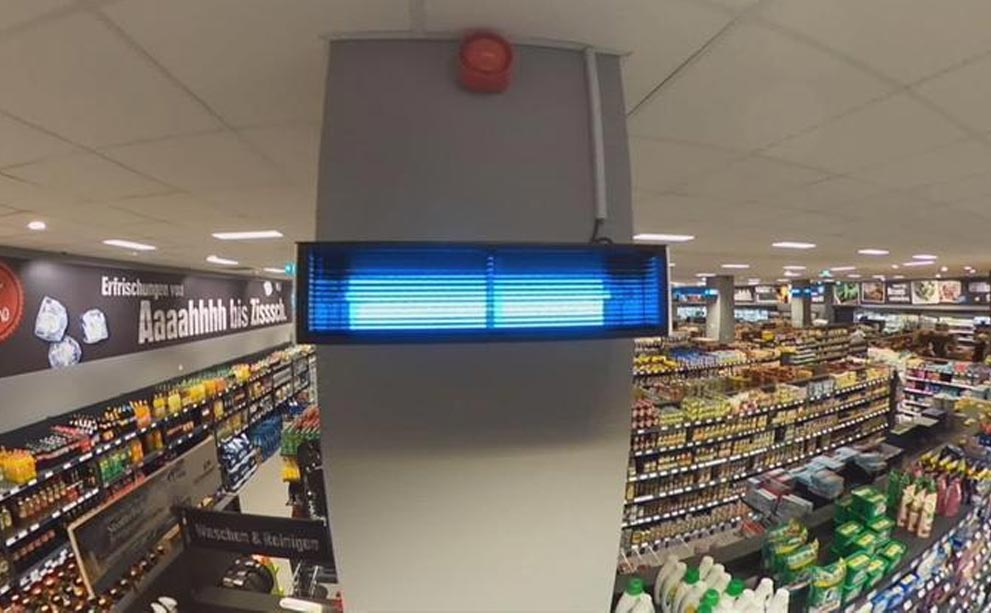
Gigahertz-Optik ensures UVC lamps provide effective and safe disinfection against coronavirus
UVC lamps installed in the upper part of rooms provide effective inactivation of airborne pathogens such as SARS-CoV-2. They can make an important contribution towards ensuring normal life in shops, offices, schools and hospitals even in these times of coronavirus.
However, it is important to ensure installations are safe for all occupants whilst providing a sufficient, but contained, dose of UVC in the upper room area.
With its X1-1-UV-3725 UVC radiometer Gigahertz-Optik supplies the perfect hand-held measuring device to obtain high-precision measurements of low-pressure mercury lamp-based installations. It enables testing in accordance with international safety standards as well as ensuring an effective germicidal dose is achieved.
For UVC LED based systems the model X1-1-UV-3726 is recommended as it additionally incorporates calibration factors at LED centre wavelengths 260nm-290nm. For far-UV germicidal sources such as excimer lamps (222nm), model X1-1-UV-3727 should be selected. It measures irradiance in the range from 200 to 300 nm and is calibrated for use with excimer lamps (222nm), UVC LEDs and low-pressure mercury lamps (254nm).
The detectors of the UV-37xx series were specially developed for radiometric measurements in the ultraviolet spectral range and have proven themselves in industrial and scientific use for many years. They are pre-aged with UV radiation for long-term stability, provide a strictly linear response, reject ambient light and incorporate a precision cosine response diffuser.
Each UVC radiometer is calibrated in our own DIN EN ISO / IEC 17025: 2018 accredited laboratory (DAkkS-certified).
The safe and effective use of germicidal UVC light sources can be guaranteed using the Gigahertz-Optik range of UVC radiometers.
You can find more information here:
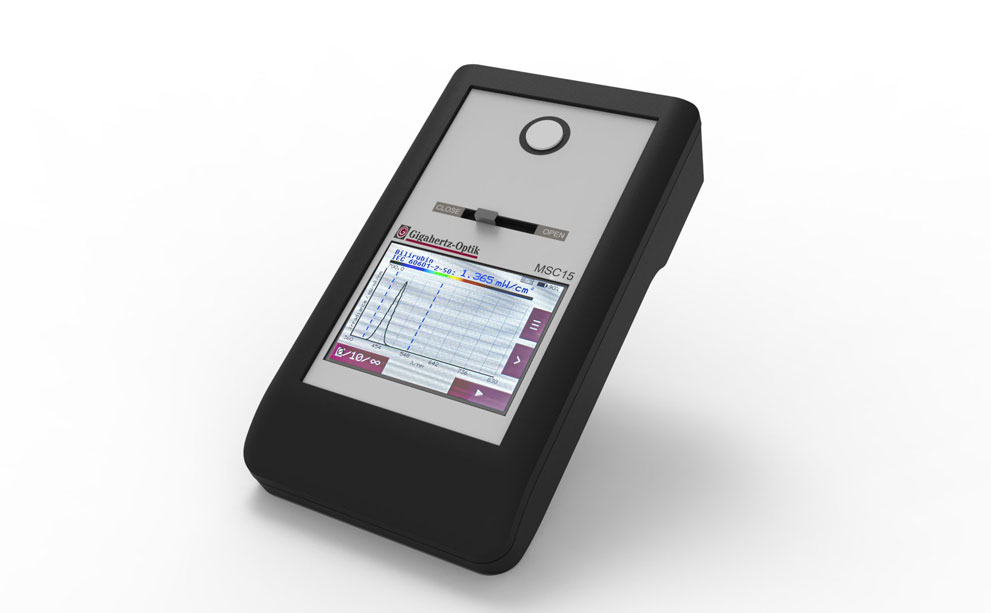
MSC15-Bili Blue light phototherapy irradiance meter for all lamp types
The MSC15-Bili is a compact spectral light meter for measuring irradiation intensity of blue light phototherapy systems irrespective of the lamp type or manufacturer. The meter conveniently measures the average and integrated irradiance in accordance with IEC 60601-2-50 and AAP Guidance. Each meter is supplied with a traceable calibration certificate from the ISO-17025 accredited Gigahertz-Optik laboratory.
The diverse range of available treatment lamps, which includes LEDs, various fluorescent tube types, tungsten halogen and metal halide lamps, produce widely differing spectral outputs. As there is no accepted action spectra for blue light phototherapy, manufacturers have tended to offer proprietary radiometers that are matched to their specific light source only. Significant errors can occur if used with other lamp types.
The MSC15-Bili spectral light meter provides a universal solution as it measures the actual spectral irradiance produced by the lamp and provides display modes in accordance with the latest standards and guidance. It directly displays total irradiance for bilirubin, Ebi (mW/cm2) in accordance with IEC 60601-2-50:2009+A1:2016 as well as average spectral irradiance (µW/cm2/nm) in accordance with the latest American Academy of Pediatrics, AAP, recommendations. Full spectral data is also available which enables the emulation of any proprietary wavelength band specified by a lamp manufacturer.
The meter provides individual display screens for AAP 2004 Guidance 430 nm – 490 nm and AAP 2011 Guidance 460 nm – 490 nm (μW/cm2/nm), and IEC 60601-2-50 Ebi, 400 nm – 550 nm (mW/cm2). Additionally, the meter measures spectral irradiance 360 nm – 830 nm providing lux, CCT and x,y chromaticity values. The AAP spectral irradiance range is better than: 0.01 – 250 µW/cm2/nm. The user can configure the meter to display only the required display screens. A color touch screen display provides intuitive handheld operation. The battery, designed for a full working day, can be charged with common USB chargers. The MSC15-Bili can also be operated via its USB interface with the included software.
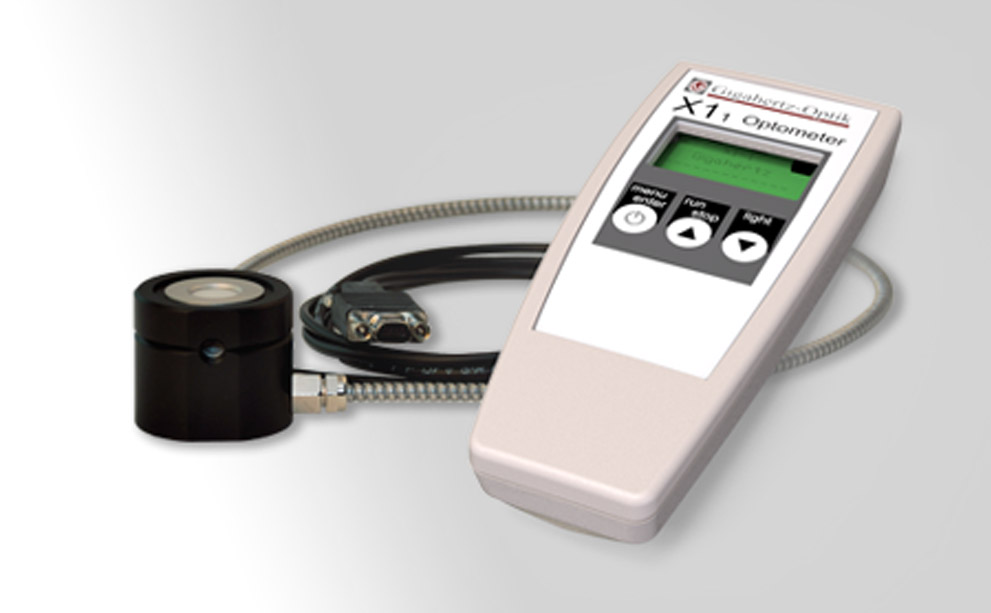
UVC Radiometer for Germicidal UV Sources including 222nm Excimer Lamps
The new X1-1-UV-3727 radiometer is designed to accurately measure the far-UVC irradiance or dose produced by 222nm excimer lamps. This is in addition to the measurement of other germicidal UV source types including low pressure Hg lamps and UV LEDs. Each meter has a wide dynamic range and is supplied with a traceable calibration certificate from the ISO-17025 accredited Gigahertz-Optik laboratory.
Far-UVC radiation, such as the 222nm produced by Kr-Cl excimer lamps, has been the subject of many studies and is known to be effective against a wide range of pathogens. Significantly, it is also thought to offer less photobiological hazard because far-UVC light cannot penetrate human skin as deeply as the longer wavelength UV radiation produced by low pressure Hg lamps and UVC LEDs.
TheX1-UV-3727 radiometer measures UV-C irradiance over a very wide dynamic range from 0.002 µW / cm² to 1000 mW / cm² which permits the investigation of both germicidal efficacy as well as hazard. It is supplied with calibrations at 222 nm for excimer lamps, 254 nm for low pressure Hg lamps, and wavelength dependent calibration factors given in 5 nm increments 250 nm to 300 nm for UV LEDs. The detector’s flat spectral responsivity ensures lowest measurement uncertainty irrespective of the precise wavelength of UV LEDs which inevitably varies according to operating conditions and manufacturing tolerances.The handheld meter provides a real time display of irradiance (mW / cm²) or dose (mJ / cm²) and includes a peak-hold function. The device may also be operated via its USB interface with optional S-X1 software. To correctly measure irradiance the detector’s entrance optic is a diffuser with a cosine field of view. The detector is pre-aged to significantly reduce solarization effects that results from long term exposure to UV radiation.
Gigahertz-Optik operates an extensive calibration facility that is DIN EN ISO / IEC 17025 accredited. In addition to the absolute radiometric calibration, every UV radiometer produced by Gigahertz-Optik is individually calibrated with regard to its relative spectral responsivity. In accordance with CIE 220:2016 this enables spectral mismatch error to be corrected for, thereby reducing the overall measurement uncertainty.

Lighting Research Center - Online UV Measurement Course
The COVID-19 pandemic has led to a growing interest in the use of UV (ultraviolet) systems for disinfection in a range of applications. However, it is important that anyone who is interested in applying UV in buildings understands how to properly specify and measure UV lighting products and systems.
The Lighting Research Center (LRC) at Rensselaer Polytechnic Institute has been conducting research in the area of UV disinfection systems for over 20 years, including the proper measurement, evaluation, and application of these systems. Based on this knowledge, the LRC has developed an online course on UV measurement and application to assist lighting specifiers, facility managers, end-users and others to ensure that the UV systems they select are safe, being applied properly in each application, and are effective at providing required disinfection properties.
Gigahertz-Optik will sponsor the online course and will provide UV radiometric instrumentation to demonstrate measurement techniques and how to properly evaluate UV disinfection products in terms of UV-C germicidal efficacy and health hazard assessment.
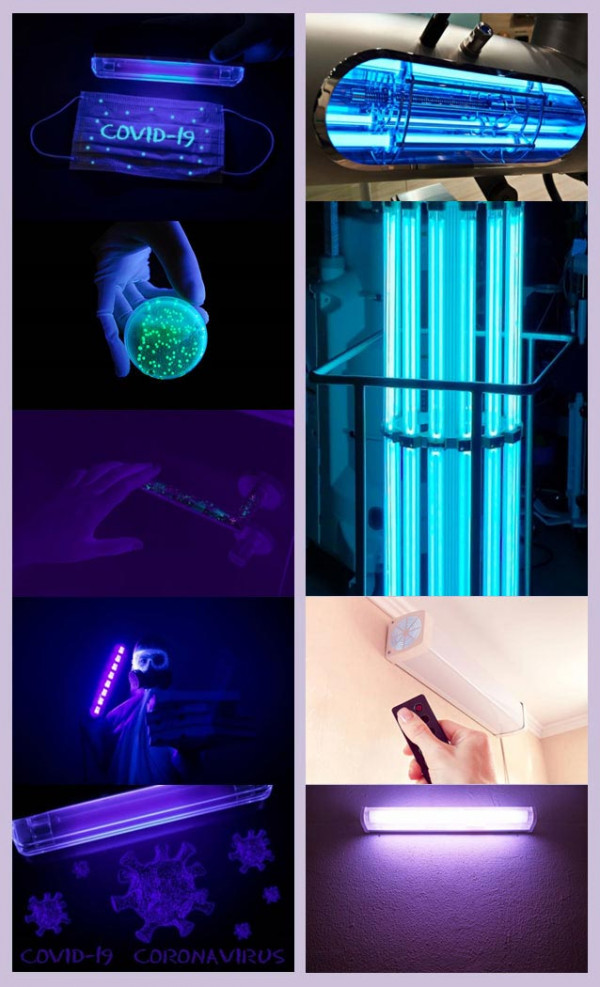
Clink the link below to find more information and to register for the course which will be held online on September 14 and 16, 2020.
LRC Online UV Course - Measurement and Application
Lean more about LRC research in the UV systems by watching this video:
Contact us for more information:
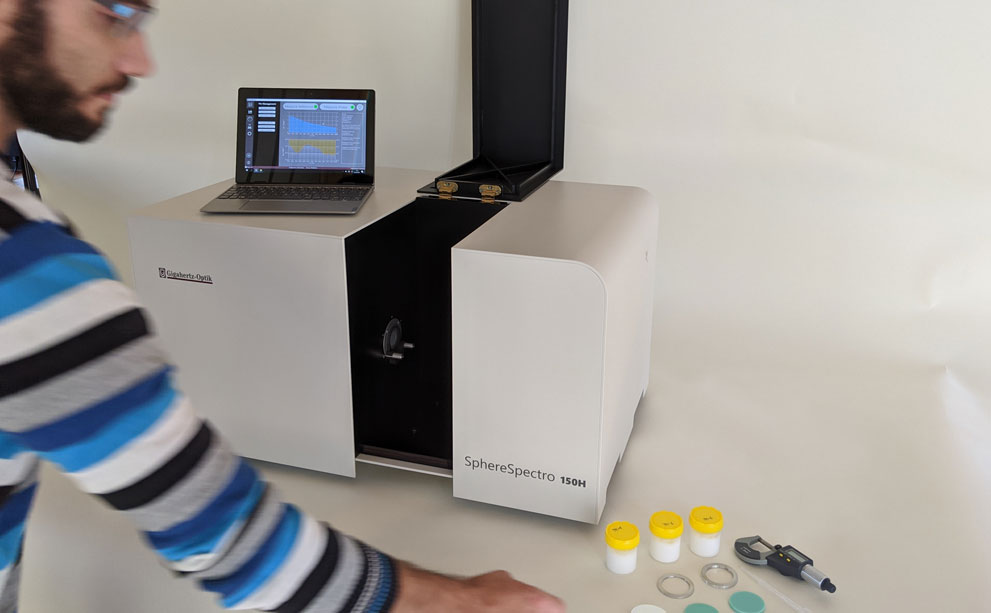
Innovative spectrometer system for determining the scattering and absorption coefficients of turbid
With the new and unique SphereSpectro 150H spectrometer system, Gigahertz-Optik offers a solution for simultaneously determining the spectral absorption and scattering coefficients for scattering samples. Conventional spectrophotometers (also called transmission spectrometers or absorption spectrometers) are used to determine the absorption coefficient of clear or colored media. In a similar way to these conventional systems, the SphereSpectro 150H is used to determine the spectral absorption coefficient of scattering media. To do this, the sample is illuminated and the transmitted as well as the reflected light is measured and evaluated in a differentiated manner using radiative transfer theory. For clear samples the absorption coefficient is determined based on Beer-Lambert's law. However, if the sample exhibits scattering (i.e turbid or translucent samples), the entire physical process must be taken into account, i.e. a combination of scattering and absorption properties.p>
With the innovative SphereSpectro 150H spectrometer system from Gigahertz-Optik the absolute absorption coefficient can now also be determined for scattering media independent of the scattering properties of the turbid medium. At the same time, the effective scattering coefficient of the sample is determined, which provides additional information about the microstructure of the sample. This is a unique feature, which is not otherwise available on the market. The determined absorption coefficient is identical with the absorption coefficient determined conventionally for clear media and can be used for content determinations, for example. The SphereSpectro 150H uses an integrating sphere to measure the total reflected and transmitted light of an illuminated sample. From these two quantities, the absorption coefficient and the effective scattering coefficient are calculated based on the radiative transfer equation.
The SphereSpectro 150H covers the wavelength range between 200 nm and 2150 nm. Modular versions are also available for sub-ranges within this entire spectral range. The unique measuring system is also characterized by simple operation, short measurement times and a large sample chamber with optimized sample holder whilst keeping overall size to a minimum.
SphereSpectro150H
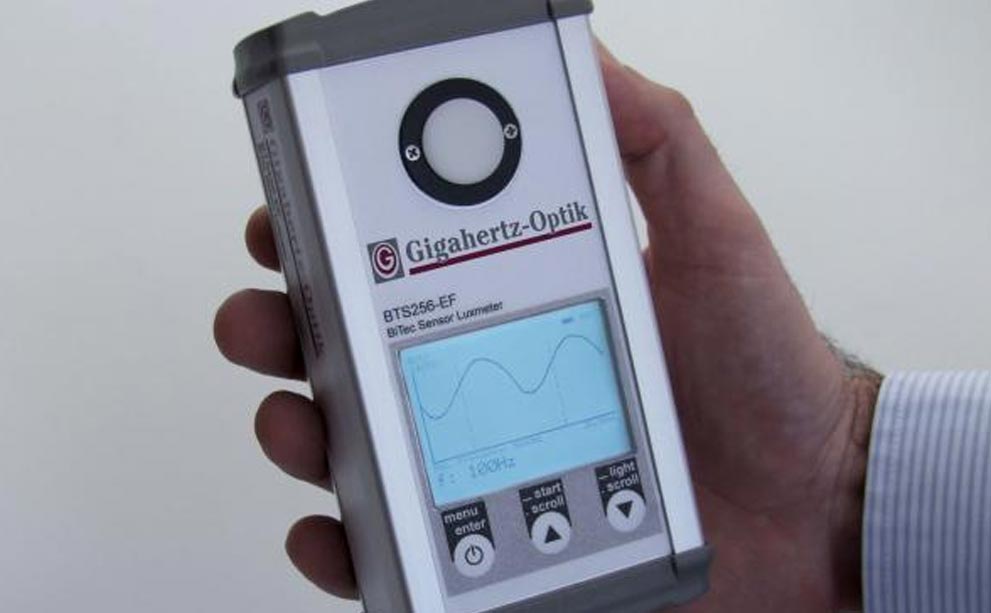
New: Enhanced flicker frequency range, BTS256-EF now measures up to 40 kHz
The lighting industry requires very versatile and reliable measurement devices when spectral light and flicker meters are concerned. The field of measurement applications and quantities is very broad: Besides illuminance and spectrum, there are many additional, more specialized properties of light sources that need to be measured like their performance in context with human centric lighting (HCL), their flicker properties, their efficiency in plant growth and many more. In all of those applications, it is crucial that the meter needs to be reliable and precise.
The BTS256-EF by Gigahertz-Optik GmbH, a well-known measuring device manufacturer, has already been up to that challenge for many years. It offers a wide selection of measuring quantities relevant in general lighting and hence acts as universal measuring device in its field. Now, the device has been updated to record and analyze even higher flicker frequencies than before: It supports signal sampling with up to 40 kHz.
Furthermore, this enhancement does not only apply to brand-new devices: By applying the latest firmware and software updates, this new feature also becomes available for devices that have been out in the field for many years. Updates are offered on request.

UV-C Radiometer for disinfection effectiveness and safety of UV-C LEDs and germicidal lamps
The X1-UV-3726 radiometer enables the effectiveness of UV germicidal irradiation (UVGI) to be accurately determined for both low pressure mercury (254nm) germicidal lamps and UV-C LEDs. Additionally, the device has sufficient sensitivity to detect if undesired exposure poses a photobiological safety risk to users. UVGI is a sterilization method that uses UV-C light to break down microorganisms such as viruses and bacteria by altering their DNA and RNA, rendering them unable to replicate.
The germicidal effectiveness of UV-C radiation depends on its dose (µJ / cm2) and wavelength. The dose is determined by measuring the irradiance (µW / cm2) and duration of exposure. The effectiveness of germicidal activity is wavelength dependent with a maximum around 265 nm which makes the potential germicidal efficacy of available UV-C LEDs greater than 254 nm emission Hg lamps.
The X1-UV-3726 radiometer measures UV-C irradiance over a very wide dynamic range to beyond 100 mW / cm² with a resolution of 0.001 µW / cm². It is calibrated for its spectral responsivity from 250 nm to 300 nm. Wavelength dependent calibration factors given in 5 nm increments are incorporated for measuring UV LEDs with known nominal wavelength. Additionally, a 254 nm calibration is included for Hg lamps as well as a general purpose 260 nm to 290 nm calibration for non-specific UV-C LEDs.
The X1-UV-3726 offers sufficient sensitivity to check for safety compliance and the effectiveness of personal protection equipment (PPE) in accordance with the accepted occupational exposure limit to actinic UV (ICNIRP). This requires irradiance levels to be < 0.2 µW/cm2 at 254 nm and < 0.1 µW/cm2 at 270 nm over 8 hour’s exposure. The handheld meter provides a real time display of irradiance or dose and includes a peak-hold function. The device may also be operated via its USB interface. Each meter is supplied with a traceable calibration certificate from the Gigahertz-Optik laboratory.

Gigahertz-Optik is now a part of the Berghof Group
The technology-focused and family-owned Berghof Group has plans for further growth, including key strategic acquisitions. It didn’t take the company long to add yet another addition to its group, and the integration process is in full swing.
Despite indications of an impending economic crisis, all signs still point to growth for Berghof in 2020. As of January 1st, 2020, the Berghof group of companies headquartered in Eningen, Germany, has acquired Gigahertz-Optik GmbH, which is located in the bavarian city Tuerkenfeld near to Munich. By this the Berghof Group grows from five to six subsidiaries and from eight to nine business units.
For over 30 years, Gigahertz-Optik has been successful in delivering metrological solutions for optical radiation for industrial applications, both nationally and internationally. In preparation for their impending retirement, the two founders and previous owners Wolfgang Daehn (second from right) and Dipl.-Ing. (FH) Anton Gugg-Helminger (second from left) have been searching for a strong new ‟home‟ for their company to make sure that their life’s work will be in good hands, and that it continues to prosper and grow.
‟Therefore we are more than happy that we have reached an agreement for the purchase of our company with our partner of choice‟, said Mr. Daehn and Mr. Gugg-Helminger with pride. In addition, the corporate cultures of both organizations blend perfectly together with their strong focus technology and their large groups of engineers. The founders will spearhead the company’s integration under the Berghof Group umbrella until their retirement. Frank Reißmann has been appointed as the new CEO, bringing more than 25 years of leadership experience from the fields of photonics, optics, measurement technology and technical ceramics.
The entire team, along with the company‘s headquarters in Tuerkenfeld will remain intact. With this strategic new addition to the group, Berghof is sending a clear message that the group will place much more focus on the field of photonics than ever before. For the Berghof Group, this field is interesting for three reasons: first, Berghof Fluoroplastics Technology GmbH is one of the leading manufacturers of high-performance optical materials based on Polytetrafluoroethylene (PTFE). Second, optical measurement devices play a key role in the laboratory industry, the playground of Berghof Products + Instruments GmbH. And third these systems are one of the key technologies in the field of autonomous driving, which in turn brings the Testing unit of Berghof Automation GmbH into play.
‟With the acquisition of Gigahertz-Optik the Berghof Group expands its product portfolio in the field of optical measurement to include light meters, spectroradiometers and other optical measurement systems as well as related recalibration services‟, Dr.-Ing. Bernd Arnold (far right) and Heinz-Uwe Vogel, CEO and CFO of the Berghof Group, are pleased. The integration of Gigahertz-Optik into the Berghof Group is already in full swing. Cross-functional teams are already working on their first joint projects.
The family-owned Berghof technology company, founded in 1966 and headquartered in Eningen, Germany, has been synonymous with intensive knowledge exchange across a variety of disciplines. This collaborative approach is expressed today in the idea of the ‟Innovation Hub‟, by which the staff live and breathe a workforce of nearly 400 professionals across nine business units. The Berghof Group serves numerous growing markets like photonics, water reuse and eMobility with plans for double-digit growth in 2020 to reach sales revenues of about 65 million Euros.

Integrated Solution for Human Centric Lighting (HCL) / Integrative Lighting Assessment
Gigahertz-Optik GmbH, Germany (EU), is the only manufacturer of precise lighting measuring equipment that provides an integrated hardware and software solution to streamline the assessment of Human Centric Lighting (HCL) / Integrative Lighting, from design and prototyping, to commissioning in real-life spaces (offices, schools, healthcare facilities, industry, hospitality etc.).
The solution can also assist with “Performance Verification (PV)” of the “WELL Building Standard” Light Concept, UL DG 24480 “Design Guideline for Promoting Circadian Entrainment with Light for Day-Active People” , and it is compliant with CIE S026/E:2018 “ClE System for Metrology of Optical Radiation for ipRGC-Influenced Responses to Light” reporting.
Furthermore, it can provide precise real-time assessment of the Eh/Evmel performance metric.
As a result of the collaboration of Gigahertz-Optik with Dr. Octavio L. Perez, Ph.D, WELL Accredited Professional (WELL AP), independent expert consultant in HCL, and adjunct researcher at Mount Sinai Hospital in New York City, NY, Gigahertz-Optik provides an integrated solution for Human Centric Lighting (HCL) / Integrative Lightingassessment where horizontal and vertical measurements can be taken simultaneously, at the same time.
Up to now, assessing Human Centric Lighting (HCL) / Integrative Lighting has been a challenging process for researchers, lighting fixtures manufacturers, architects, engineers, facilities managers, lighting designers and end-users. The typicalworkflow consisted in measuring light and lighting conditions with spectrometers and proprietary software, saving the different (horizontal and vertical) spectral measurements (SPD) in excel-readable files (typically CSV, comma separated values), and then doing calculations, first in the Lucas et al. 2014 workbook, and lately in the CIE S026/E:2018 Toolbox. Reporting was next. Certainly, a cumbersome, time-consuming and error prone process. Now, with the single push of a button you can get all the measurements and reports for HCL / Integrative Lighting (WELL Building Standard, UL DG 24480, CIE S026/E:2018) in a timesaving and error-free way.
The “WELL Building Standard” Light Concept provides different lighting requirement specifications for the built environment, in the photopic (visual), and in the circadian (non-visual) domains. The lighting system and the environment have to be assessed for compliance with several lighting quality parameters such as light levels for visual acuity (illuminance), electric light quality (color rendering -CRI and IES-TM3018- and flicker/TLA) , and circadian lighting (equivalent melanopic lux -EML- and/or CIE melanopic equivalent daylight illuminance -MEDI D65-). The software can provide reporting and mission planning for assessment and Performance Verification (PV) for the “WELL Building Standard” Light Concept, and it is compliant with CIE S026/E:2018 “ClE System for Metrology of Optical Radiation for ipRGC-Influenced Responses to Light” reporting.
According to the “WELL Performance Verification Guidebook (Q1-2020)”, all these parameters must be calculated from illuminance and spectral measurements performed with calibrated meters (calibrated as per manufacturer specifications in an ISO/IEC 17025 Accredited Calibration Laboratory and/or with NIST/USA traceable calibration).
Gigahertz-Optik is a well stablished and recognized German manufacturer of precise light and lighting measurement devices. All the devices are calibrated upon delivery and can be regularly calibrated per ISO/IEC 17025 Accredited Calibration Laboratories and/or NIST traceable facilities (upon request). The recommended laboratory and field spectral light meters for HCL / Integrative Lighting are the following:
- MSC15 precise entry-level handheld stand-alone spectrophotometer with display, battery and USB for photometric and spectral measurements and calculations.
- CSS-45 sensor for photometric and spectral measurements with USB (available with optional display CSS-D).
- BTS256-EF advanced handheld stand-alone spectrophotometer with display, battery and USB, for photometric, spectral, and flicker/TLA (Temporal Light Artifacts) measurement and calculations.
The operation of these three families of devices can also be automated through the use of different software solutions. Gigahertz-Optik also provides single device software and SDK DLLs (software development kits) to perform and automate lighting measurements (available in the Microsoft Windows operating system platform).




Integrated Solution for Human Centric Lighting (HCL) / Integrative Lighting Assessment
Gigahertz-Optik GmbH, Germany (EU), is the only manufacturer of precise lighting measuring equipment that provides an integrated hardware and software solution to streamline the assessment of Human Centric Lighting (HCL) / Integrative Lighting, from design and prototyping, to commissioning in real-life spaces (offices, schools, healthcare facilities, industry, hospitality etc.).
The solution can also assist with “Performance Verification (PV)” of the “WELL Building Standard” Light Concept, UL DG 24480 “Design Guideline for Promoting Circadian Entrainment with Light for Day-Active People” , and it is compliant with CIE S026/E:2018 “ClE System for Metrology of Optical Radiation for ipRGC-Influenced Responses to Light” reporting.
Furthermore, it can provide precise real-time assessment of the Eh/Evmel performance metric.
As a result of the collaboration of Gigahertz-Optik with Dr. Octavio L. Perez, Ph.D, WELL Accredited Professional (WELL AP), independent expert consultant in HCL, and adjunct researcher at Mount Sinai Hospital in New York City, NY, Gigahertz-Optik provides an integrated solution for Human Centric Lighting (HCL) / Integrative Lightingassessment where horizontal and vertical measurements can be taken simultaneously, at the same time.
Up to now, assessing Human Centric Lighting (HCL) / Integrative Lighting has been a challenging process for researchers, lighting fixtures manufacturers, architects, engineers, facilities managers, lighting designers and end-users. The typicalworkflow consisted in measuring light and lighting conditions with spectrometers and proprietary software, saving the different (horizontal and vertical) spectral measurements (SPD) in excel-readable files (typically CSV, comma separated values), and then doing calculations, first in the Lucas et al. 2014 workbook, and lately in the CIE S026/E:2018 Toolbox. Reporting was next. Certainly, a cumbersome, time-consuming and error prone process. Now, with the single push of a button you can get all the measurements and reports for HCL / Integrative Lighting (WELL Building Standard, UL DG 24480, CIE S026/E:2018) in a timesaving and error-free way.
The “WELL Building Standard” Light Concept provides different lighting requirement specifications for the built environment, in the photopic (visual), and in the circadian (non-visual) domains. The lighting system and the environment have to be assessed for compliance with several lighting quality parameters such as light levels for visual acuity (illuminance), electric light quality (color rendering -CRI and IES-TM3018- and flicker/TLA) , and circadian lighting (equivalent melanopic lux -EML- and/or CIE melanopic equivalent daylight illuminance -MEDI D65-). The software can provide reporting and mission planning for assessment and Performance Verification (PV) for the “WELL Building Standard” Light Concept, and it is compliant with CIE S026/E:2018 “ClE System for Metrology of Optical Radiation for ipRGC-Influenced Responses to Light” reporting.
According to the “WELL Performance Verification Guidebook (Q1-2020)”, all these parameters must be calculated from illuminance and spectral measurements performed with calibrated meters (calibrated as per manufacturer specifications in an ISO/IEC 17025 Accredited Calibration Laboratory and/or with NIST/USA traceable calibration).
Gigahertz-Optik is a well stablished and recognized German manufacturer of precise light and lighting measurement devices. All the devices are calibrated upon delivery and can be regularly calibrated per ISO/IEC 17025 Accredited Calibration Laboratories and/or NIST traceable facilities (upon request). The recommended laboratory and field spectral light meters for HCL / Integrative Lighting are the following:
- MSC15 precise entry-level handheld stand-alone spectrophotometer with display, battery and USB for photometric and spectral measurements and calculations.
- CSS-45 sensor for photometric and spectral measurements with USB (available with optional display CSS-D).
- BTS256-EF advanced handheld stand-alone spectrophotometer with display, battery and USB, for photometric, spectral, and flicker/TLA (Temporal Light Artifacts) measurement and calculations.
The operation of these three families of devices can also be automated through the use of different software solutions. Gigahertz-Optik also provides single device software and SDK DLLs (software development kits) to perform and automate lighting measurements (available in the Microsoft Windows operating system platform).

Measurement solutions for ecodesign regulations and HCL applications on
Gigahertz-Optik will be presenting some of its innovative light measurement solutions at this year’s Light + Building including the MSC15 and https://www.gigahertz-optik.com/en-us/product/bts256-ef/ spectral light and flicker meters as well as the versatile CSS-45 spectral sensor configured for Human Centric Lighting performance verification..
The European ecodesign Regulation (EU) 2019/2020 imposes strict requirements for flicker and stroboscopic effect. The metrics specified are PstLM short-term flicker severity and SVM stroboscopic visibility measure. Both these metrics are conveniently measured by the BTS256-EF meter and its software. With the addition of the LPS-CH-500 signal generator and software, the BTS256-EF performs the EMC electromagnetic immunity tests required by IEC TR 61547-1:2017.
The melanopic stimulus metric together with the spectral composition of lighting are fundamental to understanding in the field of Human Centric Lighting. These measures are provided by all of the spectral light meters from Gigahertz-Optik including the popular MSC15. Additionally, the BTS256-EF reports all the metrics to characterize the non-visual stimulus of light as defined by CIE publication S026:2018. A system incorporating two CSS-45 spectral sensors provides direct assessment against emerging standards such as the “WELL Building Standard” with regard to non-visual requirements of lighting.
Visit us in Hall 8.0, Booth H50 on the Berghof Fluoroplastic Technology GmbH stand. Gigahertz-Optik is part of the Berghof Group.

PLL-1701 - High-speed transimpedance log/lin amplifier with internal integrating sphere
With its new high-speed transimpedance amplifier PLL-1701 Gigahertz-Optik offers a versatile solution for use with either external photodiodes or its internal integrating sphere and detector combination. This compact device incorporates both logarithmic and linear amplifiers and can provide an analogue voltage output or a digitized output of the input signal current. Application software is included and an SDK is available for full integration and automation.
The PLL-1701 offers nine linear amplifier stages each with an identical rise time of 16µs. The maximum input current is 1mA and output signals can be up to +/- 5V. Additionally, the PLL-1701 offers a single-range logarithmic amplifier which can be used for applications with very fast dynamic fluctuations such as fast positioning tasks or pulsed light sources with very wide dynamic ranges. The voltage output of the Analogue/Analogue mode (AA) is suitable for use with oscilloscopes and other data acquisition systems (e.g. datalogger). The PLL-1701 also offers an Analogue to Digital Conversion mode (ADC) in which the input current signals are digitized by the internal processor and output via RS422 and USB 2.0 interfaces.
Data analysis is done with either the included application software or the available Software Development Kit (SDK). Evaluation routines for light flicker assessments (including PstLM, SVM, flicker frequency, flicker index) are already implemented in the software and also in the SDK and can thus be used directly. Therefore, the PLL-1701 complies with international standards for temporal light modulation (TLM) applications including the EU Ecodesign Directive, CIE TN006:2016, and NEMA 77-2017. Furthermore, the PLL-1701 has an internal integrating sphere with an extended range InGaAs photodiode. FC-terminated fibers can be directly connected allowing their power (A/W/nm) to be measured in the spectral range from 400-1550nm. The InGaAs photodiode signal is also output in both AA and ADC modes. https://www.gigahertz-optik.com/en-us/product/PLL-1701 .



Measurement solutions in HCL applications and in accordance with the Ecodesign Directive at Light an
Gigahertz-Optik will be presenting some of its innovative light measurement solutions at this year’s Light + Building including the MSC15 and BTS256-EF spectral light and flicker meters as well as the versatile CSS-45 spectral sensor configured for Human Centric Lighting performance verification..
The European ecodesign Regulation (EU) 2019/2020 imposes strict requirements for flicker and stroboscopic effect. The metrics specified are PstLM short-term flicker severity and SVM stroboscopic visibility measure. Both these metrics are conveniently measured by the BTS256-EF meter and its software. With the addition of the LPS-CH-500 signal generator and software, the BTS256-EF performs the EMC electromagnetic immunity tests required by IEC TR 61547-1:2017.
The melanopic stimulus metric together with the spectral composition of lighting are fundamental to understanding in the field of Human Centric Lighting. These measures are provided by all of the spectral light meters from Gigahertz-Optik including the popular MSC15. Additionally, the BTS256-EF reports all the metrics to characterize the non-visual stimulus of light as defined by CIE publication S026:2018. A system incorporating two CSS-45 spectral sensors provides direct assessment against emerging standards such as the “WELL Building Standard” with regard to non-visual requirements of lighting.
Visit us in Hall 8.0, Booth H50 on the Berghof Fluoroplastic Technology GmbH stand. Gigahertz-Optik is part of the Berghof Group.

BTS256-EF measures new flicker metrics for compliance with Ecodesign Directive
The European Commission´s proposed regulation of lighting under the Ecodesign Directive will establish mandatory product performance and quality requirements on all lighting products. This new EU directive will include strict requirements for flicker and stroboscopic effect, collectively referred to as temporal light artefacts (TLA). Simple measures such as flicker index and modulation depth will not be adequate as they do not distinguish the possible TLA effects and do not account for the effect of frequency-dependent sensitivity or the wave shape of light output. The BTS256-EF spectral light and flicker meter measures the specific metrics required by the regulation, PstLM and SVM.
The metric used for flicker in the Ecodesign regulation is the parameter ‘PstLM’, short-term flicker severity, where a value of PstLM=1 means that the average observer has a 50 % probability of detecting flicker. The metric used for stroboscopic effect in this regulation is ‘SVM’, stroboscopic visibility measure, where SVM = 1 represents the visibility threshold for an average observer.
The limits in this new EU directive are currently discussed to be PstLM < 1.0 and SVM < 0.4 although there is lobbying from the lighting industry to relax the SVM limit to <1.6. Regardless, meeting these demanding limits, particularly for SVM, will require considerable effort by manufacturers prior to the September 2021 enforcement date.
Besides full TLA measures, the BTS256-EF in conjunction with its provided software provides comprehensive photometric and colorimetric data required for general lighting applications. Additional functions are also provided for specialist tasks such as horticultural and human centric lighting.

New stray light correction method enables UV hazard measurements with array spectroradiometer
A new stray light correction method implemented in the BTS2048 UV array spectroradiometer now enables applications previously only possible with double monochromator systems. This novel method was presented at the CIE’s 29th quadrennial session.
It combines Out-of-Range and In-Band stray light correction techniques, thereby greatly increasing the dynamic range of accurate UV measurements. This performance is particularly beneficial for the assessment of UV hazards in accordance with the measurements required by IEC / DIN EN 62471, EU Directive 2006/25/EC and ICNIRP guidelines.
The compact BTS2048-UV-S is convenient for in-situ measurements as well as laboratory based setups. This hybrid stray light correction method has been incorporated into the latest S-BTS2048 software.

Measurement of a 450 W xenon lamp (at 180 mm) with a double monochromator reference and BTS2048-UV-S with and without correction.

New photometric detector for very low illuminance measurements
To meet the demands of the increasing number of very low light level applications, Gigahertz-Optik has introduced the VL-3707 precision photometric detector capable of accurate measurements down to less than 100 μlux.
For example, the VL-3707 is suitable for testing and characterising night vision equipment used in surveillance, security and automotive applications. The measurement of moonlight and starlight (mlux to μlux) enables research on light pollution of the night sky. Emergency lighting standards (e.g. DIN EN 1838 and ISO 30061) require measurement resolution in the mlux range.
The VL-3707 incorporates a latest technology photodiode, high transmission photometric filtering, and a cosine diffuser to create a highly sensitive illuminance detector. Used in conjunction with the Gigahertz-Optik P-9710 Optometer, the VL-3707 provides a sufficiently high signal-to-noise ratio for reliable measurements even in the 100 μlux range.


Total Ozone Column (TOC) system at PMOD/WRC with array spectroradiometer
The Physikalisch-Meteorologisches Observatorium Davos and World Radiation Center (PMOD/WRC) has developed a cost effective system, KOHERENT, based on a Gigahertz-Optik BTS2048-UV-S-F array spectroradiometer to retrieve TOC from a full spectrum in the UV band 300 nm – 350 nm thereby reducing the uncertainty of the ozone retrieval. Furthermore a traceability of TOC measurements was ensured.
See p33 of annual report

Gigahertz-Optik Product Update - MSC15 now with built-in memory and advanced Settings
As part of a product update, the range of functions of the compact MSC15 spectral light meter (https://www.gigahertz-optik.com/en-us/product/msc15) has been extended. The device is particularly suited to the measurement of LED based lighting in terms of illuminance, spectrum, color, CRI, PAR and human centric lighting metrics.
With this update the device gets internal memory for the local storage of up to 10 measurements which can be either managed directly by the MSC15 or by the supplied software.
In addition, a menu for individually switching on and off the possible display screens has been added. This user customization no longer requires connection to a PC thereby simplifying the configuration of the device for individual measurement tasks.
The MSC15 offers simple and intuitive operation, fast display of measurement results and traceable calibration. It can be used to measure any light source, displaying spectral irradiance from 360 nm - 830 nm as well as photometric and colorimetric data including photopic, scotopic and melanopic illuminance, color rendering indices, color temperature and CIE chromaticity. For horticultural applications, the MSC15 also directly displays PAR PPFD in μmol/m2/s.

https://www.gigahertz-optik.com/en-us/product/msc15

Gigahertz-Optik presents the latest product innovations for laser radiation measurement at LASER - W
The LASER World of PHOTONICS (June 24 to 27, Munich Trade Fair Center) offers the perfect opportunity to make important contacts within the photonics industry and to find out about the wide range of technologies and systems relating to photonics. This meeting of research and industry promotes the benefits and further development of the photonics industry. Gigahertz-Optik will present new products in the field of laser measuring technology at the fair. The locally based team is looking forward to a lively exchange and interesting discussions about light measurement technology with you.
As a supplier of measuring systems as well as testing and calibration services, Gigahertz-Optik is represented in numerous application fields of light measurement technology. Gigahertz-Optik offers a variety of solutions, especially for the complete characterization of laser radiation (power, pulse shape or pulse energy). Thus, for example, measurement systems can be put together which consist of either a standard or custom integrating sphere and a broadband detector or spectroradiometer (UV, VIS, NIR) to suit the application. For absolute and precise measurements, the systems are calibrated in the laboratory of Gigahertz-Optik which provides traceability to national metrology institutes. New product innovations in the area of compact and miniaturized integrating spheres as well as new developments of high-resolution detector systems will be presented at the fair.
Another focus is the measurement of optical properties of materials for research and industrial applications. Optical quantities such as absorption, transmission and reflection are measured with specially adapted integrating sphere systems. A typical setup includes a light source, a custom integrating sphere, and a detector. It's best to discuss your own particular requirements with your local technical representative. Gigahertz optics will be exhibiting in hall A2 at booth number 500.

DOE Releases Study on Handheld Flicker Meters
Gigahertz-Optik's BTS256-EF Light-Color-Spectral-Flicker Meter Included
The U.S. Department of Energy (DOE) has released the findings of a new study on handheld flicker meters. Flicker - or, more precisely, temporal light modulation - is a repetitive variation in light output over a large frequency range, often exacerbated by relative eye or object movement. Flicker can have adverse effects on health and visual performance.
Handheld meters from several different manufacturers were tested for performance as it relates to Percent Flicker and Flicker Index, as well as the performance at maximum and dimmed light output levels across all light sources tested. See the full report for exact product model numbers and description of laboratory testing, as well as explanations on the limitations of some meters.
The BTS256-EF which was included in the study provides the flicker parameters shown in the table either displayed on the meter itself or through the supplied S-BTS256 Software:
| Ev (t) | illuminance over time graphic |
|
| Ev,min | minimal illuminance | lx |
| Ev,max | maximal illuminance | lx |
|
| Flicker Percent | % |
|
| Flicker Index | a.u. |
| f_dom | dominant flicker frequency | Hz |
| FFT | FFT flicker frequencies | Hz - % |
| PST | Short-term flicker per CIE TN 006:2016 with S-BTS256 | - |
| SVM | Stroboscopic Visibility Measure per CIE TN 006:2016 with S-BTS256 | - |
| Assist Mp | Flicker perception with S-BTS256 | - |
The BTS256-EF not only measures flicker. It measures illuminance, color quantities, spectral irradiance and PAR - Over 50 different measurands in all!

# 09-29019 Update - BTS256-EF now with Television Lighting Consistency Index (TLCI)
As LED lighting technology in the field of recording technology (e.g., studio or stadium lighting) has grown, it has been found that the previously used method of calculating the color rendering index CRI offers only limited opportunities for light assessment. Thus, the effort in post-production increases to produce realistic color impressions in the image material.
Therefore, the European Broadcasting Union (EBU) developed the Television Lighting Consistency Index (TLCI) and recommended it as EBU R 137. The TLCI is also included in the CIE Report 083: 2019 (Guide for the Lighting of Sports Events for Color Television and Film Systems, 3rd Edition), which provides recommendations for measuring the lighting conditions (color and flicker) at sporting events. For example, in the German Basketball League (BBL) there are requirements for the TLCI of the stadium lighting.
The TLCI specializes in 18 color locations that are relevant to recording and playback devices. Thus, it allows a much more accurate assessment of the quality of light and thus also improves the final quality of the recorded material.
Gigahertz-Optik has now incorporated the TLCI measurement as a method of color rendering determination into its S-BTS256 software. Thus, the 18 color locations as well as the overall rating can be read directly in the software during a measurement with the BTS256-EF and the light quality can be assessed. In combination with the integrated flicker measurement, the light for camera recordings can be assessed precisely, directly and quickly.
Here you will find all important data for the BTS256-EF.



The new BTS2048-VL is a spectral colorimeter designed for precise LED flash binning and is ideal for
LED binning, in terms of the photometric and colorimetric specifications, requires spectral colorimeters that can ensure precise measurement values within very short measurement times synchronized with the process and that support fast data read out. The new BTS2048-VL from Gigahertz-Optik meets all the requirements for precise LED flash binning.
As stipulated by the EU Guideline 2007/23EG, a CE marking and approval by the so-called Notified Bodies are compulsory for pyrotechnic flares. Outside the EU, approvals by respective authorities e.g. the United States Coast Guard are obligatory. Logging of the Bengali flame in terms of its intensity and color is part of the test procedure. The BTS2048-VL spectral colorimeter is not only well suited for this application through its high measurement speed, but also through its compact housing with a tripod socket and its measurement optics that does not have susceptible light guides.
For more information on this device, go to BTS2048-VL.

Stray light correction of an array spectroradiometer in UV spectral range
An informative presentation explaining stray light as a significant error source in UV array spectroradiometers and minimization correction methods was presented by Mike Clark of Gigahertz-Optik GmbH at the recent UV LED Technologies & Applications Conference (ICULTA) in Berlin, Germany.
Topics included definitions/illustrations of an array type and double monochromator spectroradiometer, stray light, its causes and significance for UV measurement, suppression techniques through optical design, mathematical correction based on signal distribution function (SDF) characterization matrix using a tunable laser, and long pass plus bandpass filtering with associated limitations. The implementation of stray light suppression techniques into the spectroradiometer, subsequent characterization, actual on-site testing and consequences for UV LED measurement were also main topics.
Download the full presentation.


